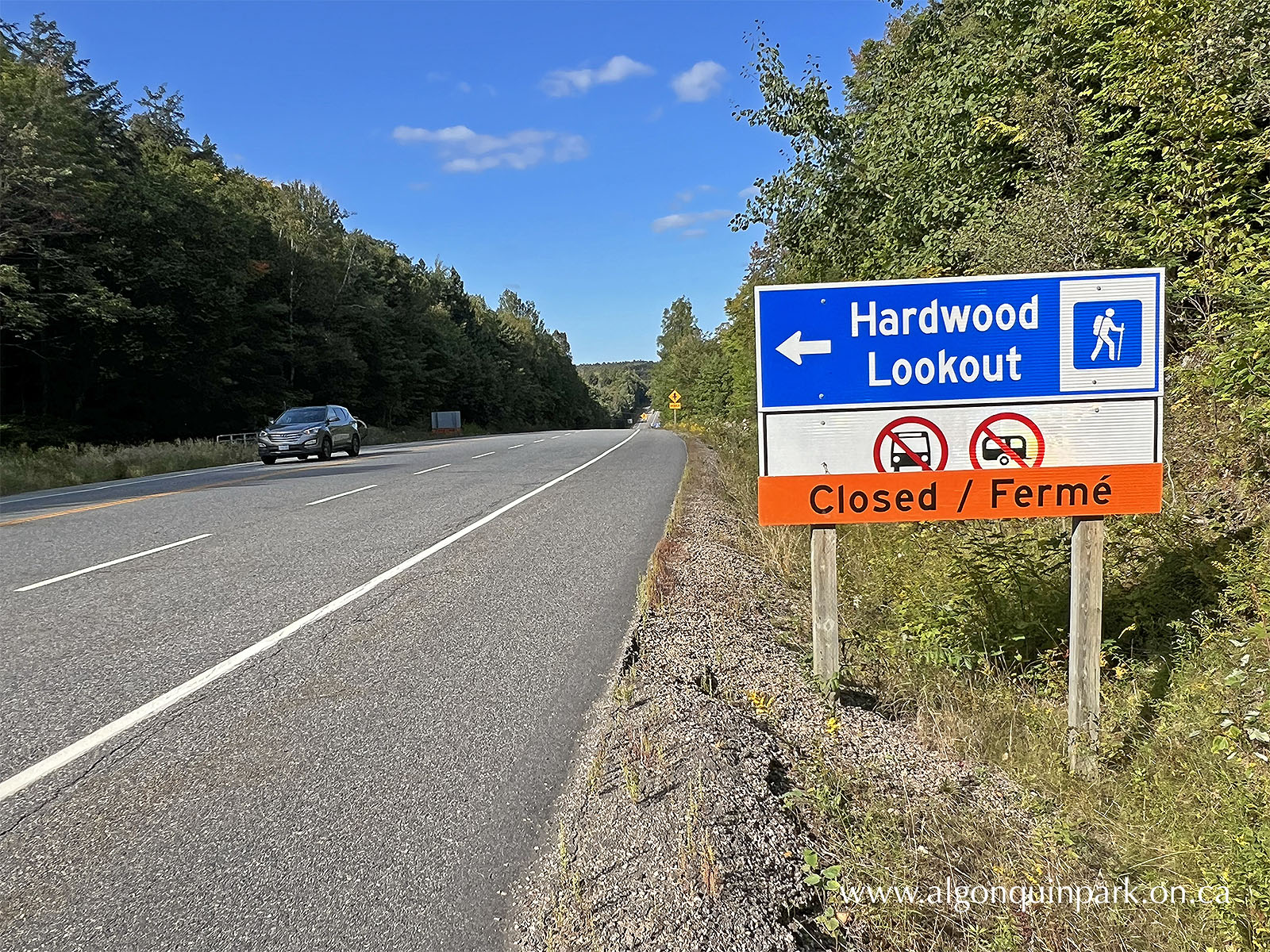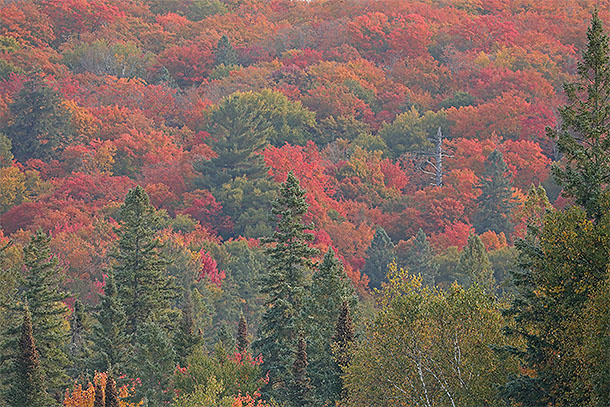Events Calendar
Current Weather
Algonquin Park Fall Colour Report
| Algonquin Park Fall Colour Reports have concluded for 2024. Please check back in early/mid-September 2025 (or as conditions warrant) for our next report. Until then, please use the resources below to plan your next autumn trip to Algonquin Park. |
Image: Fall morning at the Algonquin Park Visitor Centre on October 23, 2024. Click for a live webcam view.
Related Topics |
|||
 |
|||
Use the trip planning resources below (or links in the sidebar) to plan your fall trip to Algonquin Park.
Summary
Algonquin Park's tree species are just about ready for winter. The latest changing tree species primarily located in wetlands, the Tamarack, are now past peak. Poplars, that change colour after Sugar Maples, are now bare. Sugar Maple fall colour peaked on October 4 and now bare and prepared for winter.
Fall colour is subject to numerous environmental variables such as daylight length, moisture, temperature, frost, wind, heavy rain, etc., so the exact peak of fall colour is difficult to determine in advance. High winds, rain, or even snow can sometimes quickly result in fragile leaves being knocked off the trees increasing what is called leaf fall.
During the past 50+ years, the earliest Sugar Maple peak recorded in Algonquin Park was September 15 (1982) and the latest October 9 (1996). This year (2024), the peak date for the Sugar Maple forest in the western portion of the Highway 60 Corridor was October 4. This date is a week later than the average peak (September 27) likely a result of a slow colour change in mid-September when temperatures reached a maximum of 27°C (with humidex values feeling like 32°C) for an extended period.
See below for when the best fall colour is expected for different species and details about planning your fall trip to Algonquin Park.
For live video see the Algonquin Park Webcam or The Friends of Algonquin Park's Facebook page for additional images. Keep watching this web page for updates and the latest images as conditions warrant.
Current Status of Algonquin Park's Fall Colour
Below is the current status of Algonquin Park's fall colour change (click to enlarge). This diagram reports on the status of the most popular tree species during fall leaf colour season in Algonquin Park. Please check back throughout fall for updates as conditions warrant.
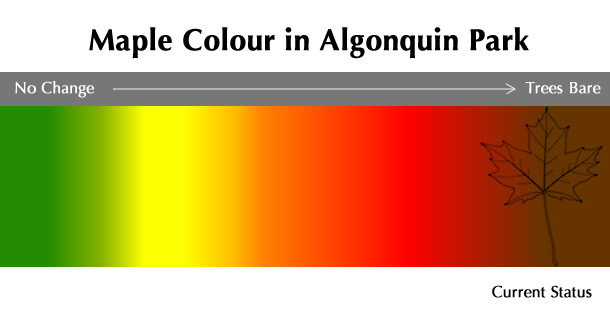
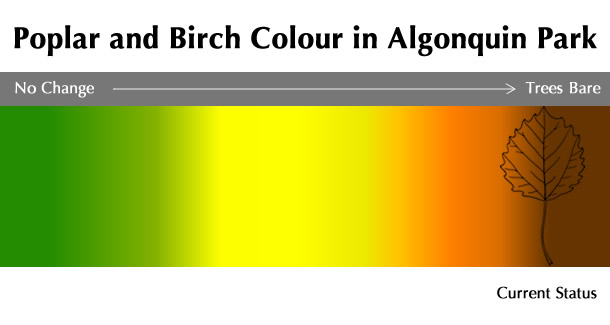
Algonquin Park is ablaze with vibrant red, orange, and yellow colors for only about a one month period in the fall. In a landscape so often dominated by the green of summer, how does this brief explosion colour happen in the early autumn? The answer involves a complex process of numerous chemicals and environmental variables. Read more at Why Does Fall Leaf Colour Change Happen?
Algonquin Park Fall Colour Season Summary 2024
Below is a summary of the Algonquin Park 2024 fall colour season annotated with imagery. Please note that the timing of the best fall colour varies from year to year, see Fall Colour History in Algonquin Park for more details.
September 3, 2024 - The temperature recorded at the East Gate of Algonquin Park dropped to just 3°C overnight. Fall colour change is noted in some of the deciduous trees in Algonquin Park, particularly Red Maples growing near wetlands and other moist soil locations.
September 8 to 11, 2024 - Overnight temperatures dips from 0°C to 2°C with a Frost Advisory issued for consecutive nights by Environment Canada.
September 13, 2024 - An increasing colour change is observed across the landscape resulting from shortening daylight length and recent cold temperatures.
September 14 to 23, 2024 - Summer-like temperatures return to Algonquin Park with highs reaching 27°C (with humid ex values feeling like 32°C). This extended period of hot temperatures stalled the recent rapid progression of fall colour change in Algonquin Park. Calm winds and little rain allow fragile leaves to remain on the twig.
September 24, 2024 - The return of more seasonal temperatures as resumed the need for fall colour change. Some early changing Red Maples are already dropping leaves from heavy rain and strong wind events. The body of the Sugar Maple forest remains yellow-green, with hints of orange.
September 26 to October 3, 2024 - A return to overnight temperatures in the single digits is increasing the colour intensity of the Sugar Maples in Algonquin Park. A later than average peak of Sugar Maples is expected.
October 4, 2024 - Peak of the Sugar Maple canopy fall colour is reached along the Highway 60 Corridor of Algonquin Park. This date is a week later than the average peak over the last 50 years.
October 5, 2024 - Early morning temperatures reach -1°C with extensive frost. The intensity of poplar fall colour is expected to increase in the days ahead.
October 6, 2024 - Stronger winds increase leaf fall of fragile Sugar Maple leaves.
October 11, 2024 - Poplars are showing their peak yellow colour along the Highway 60 Corridor of Algonquin Park. Crowns of Sugar Maples are partially bare, but mid-story remains intact and showing good colour. Tamaracks are showing an increasing yellow colour in wetland areas.
October 13 to 14, 2024 - Strong winds cause increased leaf fall pushing the yellow colour of the poplar past peak along the Highway 60 Corridor.
October 17, 2024 - Wide spread frost as temperatures dip to -5°C in the early morning hours.
October 19 to 21, 2024 - Tamarack, Algonquin Park's latest changing tree species, is showing its best colour along the Highway 60 Corridor.
October 23, 2024 - Algonquin Park's tree species are just about ready for winter. The latest changing tree species primarily located in wetlands, the Tamarack, are now past peak. Poplars, that change colour after Sugar Maples, are now bare. Sugar Maples are also bare and prepared for winter.
Check back for more updates as the fall colour season progresses.
Images of Fall 2024 in Algonquin Park
 Below are recent images of Algonquin Park during fall 2024. Click to enlarge the images and see the captions for the image date and location. For live video see the Algonquin Park Webcam or The Friends of Algonquin Park's Facebook page for additional images.
Below are recent images of Algonquin Park during fall 2024. Click to enlarge the images and see the captions for the image date and location. For live video see the Algonquin Park Webcam or The Friends of Algonquin Park's Facebook page for additional images.
Image: At km 41 of Highway 60 in Algonquin Park on October 14, 2024. (Click image to enlarge.)
Image: Highway 60 approaching the West Gate in Algonquin Park on September 10, 2024 (click to enlarge).
Image: Maple dominated hillside in Algonquin Park on September 10, 2024 (click to enlarge).
Image: At the West Gate in Algonquin Park on September 10, 2024 (click to enlarge).
Image: Along Highway 60 in Algonquin Park on September 10, 2024 (click to enlarge).
Image: Near Hardwood Lookout Trail in Algonquin Park on September 10, 2024 (click to enlarge).
Image: At km 16 of Highway 60 in Algonquin Park on September 10, 2024 (click to enlarge).
Image: At km 20 of Highway 60 in Algonquin Park on September 10, 2024 (click to enlarge).
Image: At km 8 of Highway 60 in Algonquin Park on September 10, 2024 (click to enlarge).
Image: At km 10 of Highway 60 in Algonquin Park on September 10, 2024 (click to enlarge).
Image: Along Highway 60 in Algonquin Park on September 10, 2024 (click to enlarge).
Image: View from the observation deck at the Algonquin Park Visitor Centre in Algonquin Park on September 12, 2024. Poplar dominated fall colour at the Visitor Centre peaks after the best Sugar Maple has occurred, typically in early to mid-October (click to enlarge).
Image: Highway 60 approaching the West Gate in Algonquin Park on September 13, 2024 (click to enlarge).
Image: At Tea Lake in Algonquin Park on September 13, 2024 (click to enlarge).
Image: Fall colour along Highway 60 in Algonquin Park on September 13, 2024 (click to enlarge).
Image: At Tea Lake in Algonquin Park on September 13, 2024 (click to enlarge).
Image: Hardwood forest near Smoke Lake in Algonquin Park on September 13, 2024 (click to enlarge).
Image: At km 8 of Highway 60 in Algonquin Park on September 13, 2024 (click to enlarge).
Image: Fall colour along Highway 60 in Algonquin Park on September 13, 2024 (click to enlarge).
Image: At km 20 of Highway 60 in Algonquin Park on September 13, 2024 (click to enlarge).
Image: Fall colour along Highway 60 in Algonquin Park on September 13, 2024 (click to enlarge).
Image: At km 16 of Highway 60 in Algonquin Park on September 13, 2024 (click to enlarge).
Image: Highway 60 near the Hardwood Lookout Trail in Algonquin Park on September 13, 2024 (click to enlarge).
Image: Along Highway 60 in Algonquin Park on September 13, 2024 (click to enlarge).
Image: Fall colour along Highway 60 in Algonquin Park on September 13, 2024 (click to enlarge).
Image: Highway 60 at the West Gate in Algonquin Park on September 13, 2024 (click to enlarge).
Image: Near km 10 of Highway 60 in Algonquin Park on September 13, 2024 (click to enlarge).
Image: Approaching the West Gate in Algonquin Park on September 16, 2024. (click to enlarge).
Image: Tea Lake in Algonquin Park on September 16, 2024. (click to enlarge).
Image: Near Smoke Lake in Algonquin Park on September 16, 2024. (click to enlarge).
Image: At km 8 of Highway 60 in Algonquin Park on September 16, 2024. (click to enlarge).
Image: Along Highway 60 in Algonquin Park on September 16, 2024. (click to enlarge).
Image: Brewer Lake in Algonquin Park on September 16, 2024. (click to enlarge).
Image: At km 40 of Highway 60 in Algonquin Park on September 16, 2024. (click to enlarge).
Image: Tea Lake in Algonquin Park on September 16, 2024. (click to enlarge).
Image: At km 16 of Highway 60 in Algonquin Park on September 16, 2024. (click to enlarge).
Image: At km 13 of Highway 60 in Algonquin Park on September 16, 2024. (click to enlarge).
Image: At km 10 of Highway 60 in Algonquin Park on September 16, 2024. (click to enlarge).
Image: Later changing poplar and Tamarack fall colour at km 41 of Highway 60 in Algonquin Park on September 16, 2024. (click to enlarge).
Image: Along Highway 60 in Algonquin Park on September 16, 2024. (click to enlarge).
Image: Approaching the West Gate in Algonquin Park on September 18, 2024. (click to enlarge).
Image: Sugar Maple colour along Highway 60 in Algonquin Park on September 18, 2024. (click to enlarge).
Image: Foggy morning at km 8 of Highway 60 in Algonquin Park on September 18, 2024. (click to enlarge).
Image: Fall colour in Algonquin Park on September 18, 2024. (click to enlarge).
Image: At the West Gate (km 0) in Algonquin Park on September 18, 2024. (click to enlarge).
Image: Fall colour along Highway 60 in Algonquin Park on September 18, 2024. (click to enlarge).
Image: Along Highway 60 in Algonquin Park on September 18, 2024. (click to enlarge).
Image: Approaching the West Gate of Algonquin Park on September 19, 2024.
Image: Tea Lake in Algonquin Park on September 19, 2024.
Image: Near Smoke Lake in Algonquin Park on September 19, 2024.
Image: Near Peck Lake Trail in Algonquin Park on September 19, 2024.
Image: Adult and immature Common Loons in the fall colour reflection on Tea Lake in Algonquin Park on September 19, 2024.
Image: At km 8 of Highway 60 in Algonquin Park on September 19, 2024.
Image: At km 20 of Highway 60 in Algonquin Park on September 19, 2024.
Image: At km 16 of Highway 60 in Algonquin Park on September 19, 2024.
Image: At km 13 of Highway 60 in Algonquin Park on September 19, 2024.
Image: At km 10 of Highway 60 in Algonquin Park on September 19, 2024.
Image: Fall colour along Highway 60 in Algonquin Park on September 19, 2024.
Image: At km 10 of Highway 60 in Algonquin Park on September 19, 2024.
Image: Fall colour along Highway 60 in Algonquin Park on September 19, 2024.
Image: Tea Lake in Algonquin Park on September 19, 2024.
Image: Along Highway 60 in Algonquin Park on September 19, 2024.
Image: At km 48 of Highway 60 in Algonquin Park on September 19, 2024.
Image: Brewer Lake in Algonquin Park on September 19, 2024.
Image: Fall colour and Common Loons in Algonquin Park on September 19, 2024.
Image: Rainy morning at km 13 of Highway 60 in Algonquin Park on September 21, 2024. (click to enlarge).
Image: Rainy conditions at km 20 of Highway 60 in Algonquin Park on September 21, 2024. (click to enlarge).
Image: At km 8 of Highway 60 in Algonquin Park on September 21, 2024. (click to enlarge).
Image: Approaching the West Gate in Algonquin Park on September 21, 2024. (click to enlarge).
Image: At km 10 of Highway 60 in Algonquin Park on September 24, 2024. (click to enlarge).
Image: At the West Gate of Algonquin Park on September 24, 2024. (click to enlarge).
Image: Fall colour along Highway 60 in Algonquin Park on September 24, 2024. (click to enlarge).
Image: Fall colour along Highway 60 in Algonquin Park on September 24, 2024. (click to enlarge).
Image: Along the Arowhon Road in Algonquin Park on September 24, 2024. (click to enlarge).
Image: Tea Lake in Algonquin Park on September 24, 2024. (click to enlarge).
Image: At km 13 of Highway 60 in Algonquin Park on September 24, 2024. (click to enlarge).
Image: At km 16 of Highway 60 in Algonquin Park on September 24, 2024. (click to enlarge).
Image: Along the Arowhon Road in Algonquin Park on September 24, 2024. (click to enlarge).
Image: At km 20 of Highway 60 in Algonquin Park on September 24, 2024. (click to enlarge).
Image: At km 8 of Highway 60 in Algonquin Park on September 24, 2024. (click to enlarge).
Image: Near Smoke Lake in Algonquin Park on September 24, 2024. (click to enlarge).
Image: Tea Lake in Algonquin Park on September 24, 2024. (click to enlarge).
Image: Approaching the West Gate of Algonquin Park on September 24, 2024. (click to enlarge).
Image: Foggy morning at km 16 of Highway 60 in Algonquin Park on September 29, 2024.
Image: Foggy morning near Smoke Lake in Algonquin Park on September 29, 2024.
Image: Foggy morning at km 13 of Highway 60 in Algonquin Park on September 29, 2024.
Image: Approaching the West Gate of Algonquin Park on September 30, 2024.
Image: At Tea Lake in Algonquin Park on September 30, 2024.
Image: Near Smoke Lake in Algonquin Park on September 30, 2024.
Image: At km 19 of Highway 60 in Algonquin Park on September 30, 2024.
Image: At km 8 of Highway 60 in Algonquin Park on September 30, 2024.
Image: At km 48 of Highway 60 in Algonquin Park on September 30, 2024.
Image: At km 41 of Highway 60 in Algonquin Park on September 30, 2024.
Image: Increasing poplar fall colour at km 38 of Highway 60 in Algonquin Park on September 30, 2024.
Image: Increasing poplar fall colour at km 37 of Highway 60 in Algonquin Park on September 30, 2024.
Image: At km 20 of Highway 60 in Algonquin Park on September 30, 2024.
Image: At km 16 of Highway 60 in Algonquin Park on September 30, 2024.
Image: At km 13 of Highway 60 in Algonquin Park on September 30, 2024.
Image: At km 10 of Highway 60 in Algonquin Park on September 30, 2024.
Image: At km 10 of Highway 60 in Algonquin Park on September 30, 2024.
Image: Fall colour along Highway 60 in Algonquin Park on September 30, 2024.
Image: Fall colour along Highway 60 in Algonquin Park on September 30, 2024.
Image: Fall colour along Highway 60 in Algonquin Park on September 30, 2024.
Image: Fall colour along Highway 60 in Algonquin Park on September 30, 2024.
Image: Fall colour along Highway 60 in Algonquin Park on September 30, 2024.
Image: Fall colour along Highway 60 in Algonquin Park on September 30, 2024.
Image: Fall colour along Highway 60 in Algonquin Park on September 30, 2024.
Image: Fall colour along Highway 60 in Algonquin Park on September 30, 2024.
Image: At Brewer Lake in Algonquin Park on September 30, 2024.
Image: Fall colour along Highway 60 in Algonquin Park on September 30, 2024.
Image: Fall colour along Highway 60 in Algonquin Park on September 30, 2024.
Image: Fall colour along Highway 60 in Algonquin Park on October 2, 2024.
Image: Increasing yellow fall colour at the Algonquin Park Visitor Centre in Algonquin Park on October 2, 2024. Poplar that changes a yellow colour always peaks after the best Sugar Maple fall colour.
Image: Fall colour at km 13 of Highway 60 in Algonquin Park on October 7, 2024.
Image: Approaching the West Gate of Algonquin Park on October 7, 2024.
Image: Tea Lake in Algonquin Park on October 7, 2024.
Image: Near Smoke Lake in Algonquin Park on October 7, 2024.
Image: At km 8 of Highway 60 in Algonquin Park on October 7, 2024.
Image: At km 41 of Highway 60 in Algonquin Park on October 7, 2024.
Image: Fall colour along Highway 60 in Algonquin Park on October 7, 2024.
Image: At km 38 of Highway 60 in Algonquin Park on October 7, 2024.
Image: At km 20 of Highway 60 in Algonquin Park on October 7, 2024.
Image: At km 19 of Highway 60 in Algonquin Park on October 7, 2024.
Image: At km 16 of Highway 60 in Algonquin Park on October 7, 2024.
Image: At km 10 of Highway 60 in Algonquin Park on October 7, 2024.
Image: Fall colour along Highway 60 in Algonquin Park on October 7, 2024.
Image: Fall colour at Lake of Two Rivers in Algonquin Park on October 8, 2024.
Image: Fall colour at Algonquin Park Visitor Centre in Algonquin Park on October 8, 2024. See the current view using the live webcam.
Image: Foggy fall colour morning at the Algonquin Park Visitor Centre in Algonquin Park on October 11, 2024. (Click image to enlarge.)
Image: At km 41 of Highway 60 in Algonquin Park on October 14, 2024. (Click image to enlarge.)
Image: Tamarack fall colour in Algonquin Park on October 14, 2024. (Click image to enlarge.)
Image: Poplar fall colour in Algonquin Park on October 14, 2024. (Click image to enlarge.)
Image: Remaining maple fall colour in Algonquin Park on October 14, 2024. (Click image to enlarge.)
Image: Fall colour in Algonquin Park on October 14, 2024. (Click image to enlarge.)
Image: At Brewer Lake in Algonquin Park on October 14, 2024. (Click image to enlarge.)
Image: Poplar and Tamarack fall colour in Algonquin Park on October 14, 2024. (Click image to enlarge.)
Image: Costello Lake in Algonquin Park on October 14, 2024. (Click image to enlarge.)
Image: At km 37 of Highway 60 in Algonquin Park on October 14, 2024. (Click image to enlarge.)
Image: At Ring-necked Pond in Algonquin Park on October 14, 2024. (Click image to enlarge.)
Image: Tamarack fall colour in Algonquin Park on October 14, 2024. (Click image to enlarge.)
Image: At km 48 of Highway 60 in Algonquin Park on October 14, 2024. (Click image to enlarge.)
Image: Along the Opeongo Road in Algonquin Park on October 14, 2024. (Click image to enlarge.)
Image: Frosty fall morning at the Algonquin Park Visitor Centre on October 17, 2024. (Click image to enlarge.)
Image: Algonquin Park's tree species are now prepared for winter. At the Algonquin Park Visitor Centre on October 23, 2024. (Click image to enlarge.)
When Should I Visit Algonquin Park?
A trip to Algonquin Park between mid-September and mid-October is best for observing Algonquin Park's fall colour, but more precision regarding an exact date depends upon what species of tree you are interested in observing.
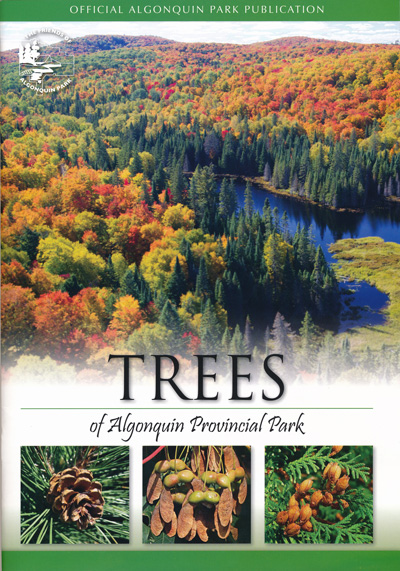 Algonquin Park is home to 34 native species of trees. Of these species 10 are classified as conifers (cone bearing) and will retain their leaves (needles) year-round and are often referred to as "evergreen". The only exception is the Tamarack that changes to golden yellow colour before dropping its needles in preparation for winter. The other 24 species of deciduous trees change colour at different times, depending upon the species, their location in Algonquin Park, and the specific environmental conditions in that area.
Algonquin Park is home to 34 native species of trees. Of these species 10 are classified as conifers (cone bearing) and will retain their leaves (needles) year-round and are often referred to as "evergreen". The only exception is the Tamarack that changes to golden yellow colour before dropping its needles in preparation for winter. The other 24 species of deciduous trees change colour at different times, depending upon the species, their location in Algonquin Park, and the specific environmental conditions in that area.
No tree happens to grow in a random location, rather each tree struggles against great odds and hazards for a place in the sun and each species is subtly equipped to do better than its competition in certain conditions. Certain species of trees grow in different locations in Algonquin Park. Therefore the mosaic of forest types in Algonquin Park is no accident but is determined by soil type, moisture, climate, etc. resulting in the amazing blend of green, yellow, orange, red, and purple colours that makes Algonquin Park's fall colour so special.
Traditionally, Algonquin Park's fall colour occurs earlier than surrounding areas because of the Park's higher elevation, up to almost 600 metres above sea level. This can mean the best colour is observed several weeks (or more!) prior to leaf colour change in places like Ottawa (70 metres above sea level), Toronto (75 metres above sea level), or even communities just outside Algonquin Park's boundaries. Algonquin Park’s high elevation, thin soils, and cooler temperatures results in a shorter growing season for all plants including its trees.
Mid-September to Early October

If visiting Algonquin Park during mid-September to early October, you will observe the colour change of the Sugar Maples and Red Maples. This fall colour covers hills in orange and red colours and is best observed at locations with expansive views such as trails and views across water. During the past 40+ years, the earliest Sugar Maple peak recorded was September 15, 1982 and the latest October 9, 1996. During 2016, the peak Sugar Maple colour was determined to be October 6 (almost record late), as a result of warm fall temperatures and a late frost. The average peak of the Sugar Maple canopy in the western portion of the Highway 60 Corridor is September 27. See the current status of Algonquin Park's colour change above.
Early to Mid-October

An Algonquin Park visit between early to mid October (including Thanksgiving) will observe the yellow-orange colours displayed by poplar and birch species, plus the orange colour of the Sugar Maple understory. This time known as the "Golden Encore" generally occurs after the Sugar Maple and Red Maple peak colour, but offers great landscape views in poplar and birch dominated areas. The eastern portion of the Highway 60 Corridor and the Park's East Side is a great location to view this colour.
Once leaves have fallen from the tops of the Sugar Maples, the understory changes colour at ground level as it was previously protected from cold temperatures by the blanket of overhead leaves. A hike along an interpretive trail dominated by maples is a great way to see understory fall colour up close.
Mid to Late October

A mid to late October visit showcases Tamarack at their peak yellow colour before dropping their needles in preparation for winter. The Tamarack is Algonquin Park's only cone bearing tree that changes colour and drops all its needles in preparation for winter. Search for Tamaracks in wetlands and bogs including the Spruce Bog Boardwalk, the Mizzy Lake Trail, or along the Opeongo Road. By late October or early November (depending upon environmental conditions) all deciduous trees are bare and prepared for winter.
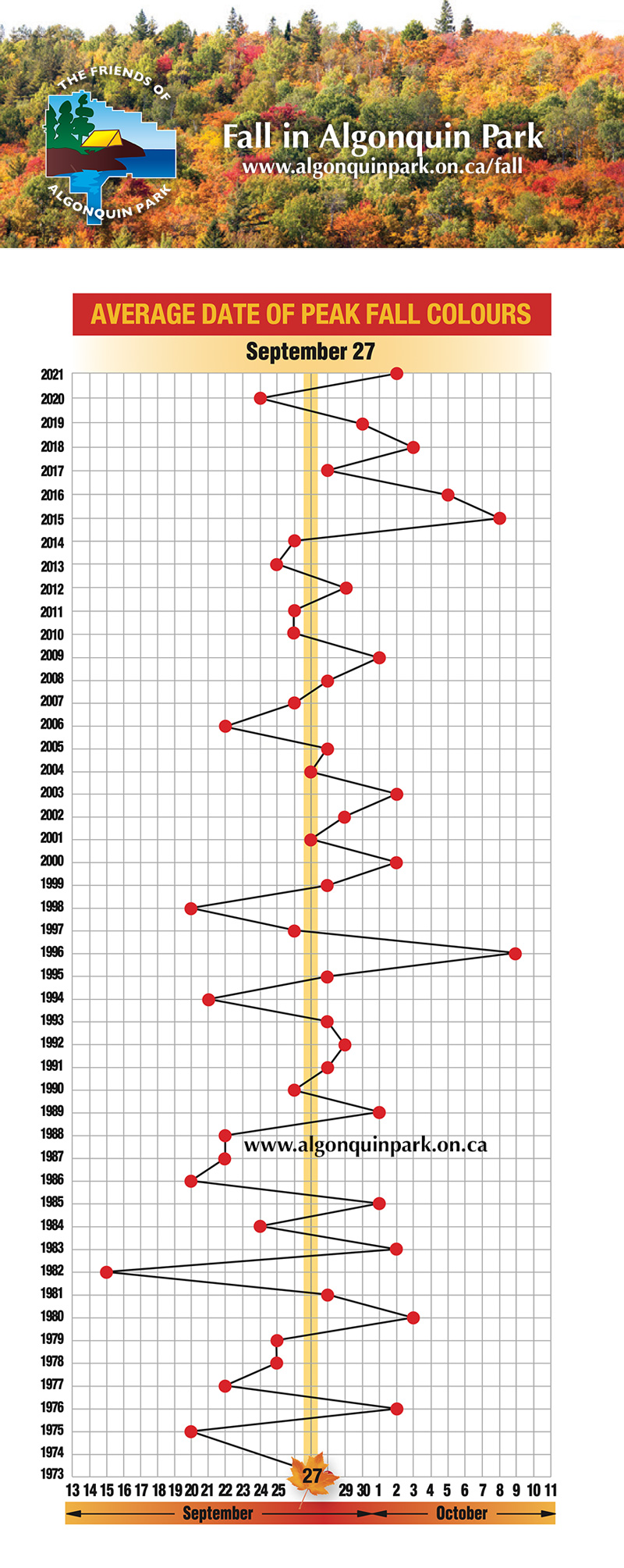 Fall Colour History in Algonquin Park
Fall Colour History in Algonquin Park
During the past 40+ years, the earliest Sugar Maple peak recorded in Algonquin Park was September 15 (1982) and the latest October 9 (1996). The average peak of the Sugar Maple canopy in the western portion of the Highway 60 Corridor is September 27.
The best fall colour watching in Algonquin Park is expected from mid-September to mid-October. Fall colour is subject to numerous environmental variables such as daylight length, moisture, temperature, frost, wind, heavy rain, etc., so the exact peak of fall colour is difficult to determine in advance. High winds, rain, or even snow can sometimes quickly result in fragile leaves being knocked off the trees increasing what is called leaf fall.
Algonquin Park's Famous Fall Colours
 In 1949, Tom Linklater was working alone at the West Gate of Algonquin Park and noted in his autobiography The Last Forest Ranger: Algonquin Park Memories...
In 1949, Tom Linklater was working alone at the West Gate of Algonquin Park and noted in his autobiography The Last Forest Ranger: Algonquin Park Memories...
“…Thanksgiving weekend was going to be very busy, as the colours were at their peak. I should have about three hundred permits made up ahead of time so that all I would have to do was fill in the driver’s name and car license number, and if he was stopping, note the place. Saturday was not that busy but Sunday was unbelievable. By about eleven o’clock I had used up all my permits. There was about a quarter mile of cars lined up waiting to get into the Park! I thought to myself this was ridiculous! These folks were not hunters or poachers, they just wanted to take some pictures of the colours that were at their best...”
Why Does Fall Colour Happen?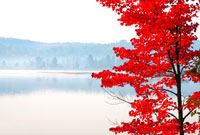
Algonquin Park is ablaze with vibrant colours during September and October. In a landscape so often dominated by the green of summer, how does this brief explosion of reds, oranges, and yellows happen in the early autumn? The answer involves a complex process of numerous chemicals and environmental variables. Read more at Why Does Fall Leaf Colour Change Happen?
Where Should I Visit in Algonquin Park?
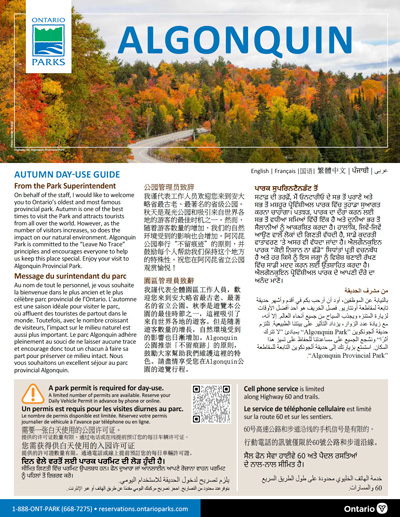 |
| Autumn Day Use Guide - EN, FR, DE, ZH, JA, KO |
The "Algonquin Dome" refers to the high elevation piece of the Canadian Shield that underlies the western two-thirds of Algonquin Park. Here an ancient mountain range continues to exist increasing elevation well above that of surrounding areas (primarily outside the Park). These ancient rolling hills covered by soils deposited by a glacier thousands of years ago, created suitable conditions for the growth of maples. The maples - primarily Sugar, Red and Striped - experience a cooler climate than those outside the Park area as a result of the higher elevation. These cooler conditions and the resulting shorter growing season make for an early fall and thus an earlier fall colour watching season than other locations in southern Ontario. Fortunately for visitors, Highway 60 runs through a large section of Algonquin Park's higher elevation. The Highway 60 Corridor provides easy access to the Park area dominated by these three species of maples for keen "leaf peepers".
Below is a satellite image taken near the peak of the Sugar Maple canopy showing the red/orange colour of the Sugar Maples and the boundary of Algonquin Park. Algonquin Park's West Side including the Highway 60 Corridor is dominated by maples, while the Park's East Side is dominated by pines that show green needles that do not change colour. This satellite image was taken on October 1, 2012.
Suggested Places for Viewing Algonquin Park's Fall Colour
Below are suggested places for viewing Algonquin Park's fall colour. These locations change according to the date and conditions observed within Algonquin Park.
- West Gate (km 0.0)
- Algonquin Art Centre (km 20)
- Two Rivers Picnic Ground and Beach (km 33)
- Rock Lake Road (km 40.3)
- Algonquin Visitor Centre (km 43.0)
- Opeongo Road (km 46.3)
- Brewer Lake (Highway 60 at km 49)
- Algonquin Logging Museum (km 54.5)
- The backcountry including access from these Access Points around the periphery of Algonquin Park:
Recommended Interpretive Walking Trails
Regardless of the exact date, Algonquin Park's Interpretive Trails are a good way to view the fall colour. Trails offering lookouts with wide vistas are especially popular around the Sugar Maple peak and the later peak of poplar and birch species. These day walking trails range in length from 800 metres to 11 kilometres in length. Trails that are suggested for fall walking include:
- Booth's Rock Trail
- Brent Crater Trail & Tower
- Centennial Ridges Trail
- Hardwood Lookout Trail (closed some days during fall, see below)
- Lookout Trail
- Peck Lake Trail
- Track and Tower Trail
- Whiskey Rapids Trail
- See all Interpretive Walking Trails
Side Roads with Foliage Viewing Opportunities
The following side roads connected to Highway 60 offer foliage viewing opportunities with lower speed traffic than Highway 60.
- Arowhon Road (at km 15.4)
- Source Lake Road (at km 20.0)
- Centennial Ridges Road (at km 37.6) - This road is best for early/mid-October viewing.
- Rock Lake Road (at km 40.3) - This road is best for early/mid-October viewing.
- Opeongo Road (at km 46.3) - This road is best for late season foliage viewing.
- Roads leading to Access Points around the periphery of Algonquin Park.
Visitor Updates for Fall 2024
|
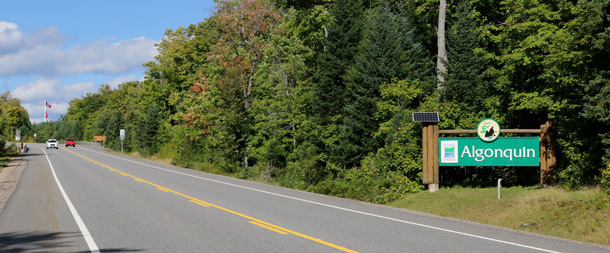
Ontario Parks continues to announce changes to visitor management strategies for fall in Algonquin Park. For this autumn, these strategies include...
How to Obtain an Algonquin Park Permit
Day Use Visitors (Daily Vehicle Permit)
- All who use Algonquin Park must have a valid permit. Day use permits allow for day visits to Algonquin Park, including access to trails, museums, beaches, picnic grounds, etc. Daily Vehicle Permits are valid from 7:00am until 10:00pm. Permits can be purchased online or via telephone up to 5 days in advance of your arrival. See more information.
- Booth Rock Trail - Special Permit Required - Ontario Parks has special capacity restrictions for Booth's Rock Trail for the fall. If you wish to walk this interpretive trail a special type of permit is required. Learn more.
- 100% of Daily Vehicle Permits (day use permits) can be purchased online (or via telephone) up to 5 days in advance, so permits may sell out in advance.
- In-person permit sales in Algonquin Park are not available, purchase online or via telephone.
- Permits are not required to be posted on your vehicle dashboard, but visitors should make sure their license plate number is correct and up-to-date. Park Wardens will be using an internet based cell phone app to confirm vehicle license plates numbers in Algonquin Park. The permit holder may change a license plate number online or over the phone if the license plate number associated with your permit is incorrect.
Seasonal Permit Holders
- Ontario Parks is advising that entry is not guaranteed for seasonal and commercial day use permit holders and is dependent upon capacity limits. Seasonal permit holders must reserve online, up to 5 days in advance, at no additional cost, to guarantee entry on a specific date. Seasonal day use permits include annual, summer, and winter versions. See more information.
Bus Permits
- Ontario Parks has implemented new policies for obtaining Bus Permits in Algonquin Park from September 1 to October 31, 2024. See more information.
Overnight Campers (Developed Campgrounds and Backcountry Campers)
- If you have a camping reservation, made up to 5 months in advance, you do not need to purchase a Daily Vehicle Permit in addition. Visitors with developed or backcountry camping reservations should proceed directly to their reserved developed campsite or backcountry access point. Permits are not required to be posted on your vehicle dashboard or campsite post, but campers should have a printed copy or digital copy of your confirmation letter as proof of your reservation with you while in Algonquin Park.
Lodge Guests
- Lodge guests with reservations for a Park lodge should proceed directly to the lodge/resort as per their confirmation details.
Traveling through Algonquin Park on Highway 60
- People traveling through Algonquin Park on Highway 60 between Oxtongue Lake and Whitney, Ontario do not need a permit. However, if you use any facilities (e.g. trail, picnic ground, bathroom, etc.) a day use permit is required.
Capacity Limits and "Sold Out" Algonquin Park
- Ontario Parks will stop selling permits for Algonquin Park once capacity is reached. When Algonquin Park has reached capacity, visitors will not be able to purchase a permit (or use a seasonal permit), and you will not be permitted to use Algonquin Park.
- Ontario Parks has not released the number of day use permits to be sold on any given day, or for different locations within Algonquin Park, or different types of permits.
When Will Algonquin Park Sell Out During Autumn?
Below is a record of dates when Daily Vehicle Permits (day use permits) were sold out in Algonquin Park in recent years. Please note that historical data is no guarantee of future permit availability.
2024 Sold Out Dates
Below is a list of dates when permits sold out in different geographic areas of Algonquin Park during fall 2024.
| Status | Date of Permit | Date Sold Out* | Geographic Area |
| Sold Out | September 28, 2024 | September 28, 2024 | Highway 60 Corridor |
| Sold Out | September 29, 2024 | September 29, 2024 | Highway 60 Corridor |
| Sold Out | October 5, 2024 | October 2, 2024 | Highway 60 Corridor |
| Sold Out | October 6, 2024 | October 5, 2024 | Highway 60 Corridor |
| Sold Out | October 12, 2024 | October 8, 2024 | Highway 60 Corridor |
| Sold Out | October 13, 2024 | October 8, 2024 | Highway 60 Corridor |
| Sold Out | October 14, 2024 | October 11, 2024 | Highway 60 Corridor |
| Sold Out | October 19, 2024 | October 19, 2024 | Highway 60 Corridor |
| Sold Out | October 20, 2024 | October 20, 2024 | Highway 60 Corridor |
| * Day use permits can be purchased up to 5 days in advance. | |||
Recent Years (2023 to 2020)
2023 Sold Out Dates
| Status | Date of Permit | Date Sold Out* | Geographic Area |
| Sold Out | September 30, 2023 | September 29, 2023 | Highway 60 Corridor |
| Sold Out | October 1, 2023 | September 30, 2023 | Highway 60 Corridor |
| Sold Out | October 7, 2023 | October 3, 2023 | Highway 60 Corridor |
| Sold Out | October 8, 2023 | October 3, 2023 | Highway 60 Corridor |
| Sold Out | October 9, 2023 | October 6, 2023 | Highway 60 Corridor |
| * Day use permits can be purchased up to 5 days in advance. | |||
2022 Sold Out Dates
| Status | Date of Permit | Date Sold Out* | Geographic Area |
| Sold Out | October 1, 2022 | September 30, 2022 | Highway 60 Corridor |
| Sold Out | October 2, 2022 | October 2, 2022 | Highway 60 Corridor |
| Sold Out | October 8, 2022 | October 4, 2022 | Highway 60 Corridor |
| Sold Out | October 9, 2022 | October 4, 2022 | Highway 60 Corridor |
| Sold Out | October 10, 2022 | October 6, 2022 | Highway 60 Corridor |
| * Day use permits can be purchased up to 5 days in advance. | |||
2021 Sold Out Dates
| Status | Date of Permit | Date Sold Out* | Geographic Area |
| Sold Out | October 2, 2021 | October 1, 2021 | Highway 60 Corridor |
| Sold Out | October 3, 2021 | October 3, 2021 | Highway 60 Corridor |
| Sold Out | October 9, 2021 | October 7, 2021 | Highway 60 Corridor |
| Sold Out | October 10, 2021 | October 7, 2021 | Highway 60 Corridor |
| Sold Out | October 11, 2021 | October 8, 2021 | Highway 60 Corridor |
| * Day use permits can be purchased up to 5 days in advance. | |||
2020 Sold Out Dates
Below is a list of dates when permits sold out in along the Highway 60 Corridor of Algonquin Park during 2020. Permits for specific geographic sections for Algonquin Park were not yet in effect.
- October 3, 2020
- October 10, 2020
- October 11, 2020
Hardwood Lookout Trail Closures
Ontario Parks has announced that Hardwood Lookout Trail will be closed on 17 days during the peak fall colour period. The shortest interpretive walking trail in Algonquin Park (and its parking lot), will be closed the following dates during fall to improve traffic flow.
- September 13, 14, 15, 20, 21, 22, 27, 28, 29, 30, 2024
- October 4, 5, 6, 11, 12, 13, 14, 2024
Limiting Occupancy to Algonquin Park Buildings
- All Algonquin Park buildings have fire code capacity restrictions. If a building is at capacity, Ontario Parks staff will require you to wait in line for entry. For your trip planning information, see the real-time occupancy at the Algonquin Park Visitor Centre, courtesy of The Friends of Algonquin Park.
Tips for Viewing Algonquin Park's Fall Colour

Coming to Algonquin Park to enjoy the best fall colour? Here are a few tips for fall colour watchers.
1. Plan Ahead
Know where you want to explore and how to get there. Use information sources such as:
2. Know When to Visit
Not all trees change colour at the same time. Traditionally, Algonquin Park's fall colour occurs earlier than surrounding areas because the Park's high elevation, thin soils, and cooler temperatures results in a shorter growing season for all plants including its trees. This can mean the best fall colour is observed several weeks (or more!) prior to leaf colour change in places like Ottawa, Toronto or even communities just outside Algonquin Park’s boundaries. Algonquin Park's fall colour season typically starts in mid-September and concludes in mid-October.
3. Know Where to Visit
No tree happens to grow in a random location, rather each tree struggles against great odds and hazards for a place in the sun and each species is subtly equipped to do better than its competition in certain conditions. Certain species of trees grow in different locations in Algonquin Park. Therefore, the mosaic of fall colour in Algonquin Park is no accident but is determined by factors such as geography, soil type, moisture, climate, etc. Check the “Where to Visit” section for more information.
4. Get a Park Permit
Everyone who uses a provincial park requires a valid permit. Learn how to obtain yours prior to arriving in Algonquin Park.
5. Stay Locally
Consider staying within Algonquin Park or just outside the Park boundary to avoid entering the Park during the busy late morning or mid-day period.
6. Consider a Weekday Visit
Fall weekends are always busier than weekdays. If possible consider a mid-week visit to Algonquin Park as all facilities are open 7-days a week during the fall colour season.
During 2024, the busiest weekends in Algonquin Park are expected to be:
- September 21/22,
- September 28/29,
- October 5/6, and
- Thanksgiving weekend (October 12/13/14).
7. Avoid Traffic Congestion
On the busiest weekends of the year, traffic can become slow or even stopped at some locations in Algonquin Park. Most visitors enter Algonquin Park via the West Gate that can experience traffic congestion during the late morning/early afternoon on peak weekends. Consider entering or exiting Algonquin Park’s Highway 60 Corridor via the quieter East Gate (near Whitney, Ontario).
8. Visit on a Cloudy Day
Many people avoid visiting Algonquin Park on cloudy or rainy days during the fall colour season. Overcast conditions cut the glare and many people agree that leaf colours appear brighter than on sunny days. An added benefit is that the Park will have fewer visitors.
9. Drive and Park Safely
If you stop to look at fall colour or wildlife, ensure you pull completely off the traveled portion of the road and watch for traffic. Never stop in a lane of traffic. When parking do so in designated areas only. Never block emergency vehicle or pedestrian access.
10. Get Away From Your Vehicle
Consider getting into a canoe, hiking a longer trail, or heading off the "beaten path" as most fall visitors stay close to their vehicles or hike only the shortest trails. Or for the adventurous visitor or one seeking solitude, head into the Park’s vast backcountry.
11. Keep Wildlife Wild
Algonquin Park is not a zoo, all animals in Algonquin Park are wild and act accordingly. Never feed or approach wildlife regardless of its size. Feeding, harming or harassing wildlife is illegal in Algonquin Park (and all provincial parks). Use caution with your cell phone camera as getting a closer image may cause you to approach an animal too closely.
12. Take Home the Proper Souvenirs
The removal of natural or cultural objects from Algonquin Park is illegal. All vegetation (including brightly coloured leaves) and other natural features are protected and can not be removed from a Provincial Park. Many Park facilities sell appropriate souvenirs as memories of your visit.
13. Be a Responsible Pet Owner
All pets must be on a leash not exceeding two metres in length and under control at all times. Pets can not produce excessive noise or harass wildlife. Pet owners must also “poop and scoop” in Algonquin Park.
14. Explore Beyond the Highway 60 Corridor
Algonquin Park covers 7,630 square kilometres and many backcountry access points around the periphery of Algonquin Park, especially on the Park’s West Side, offer excellent fall colour viewing with fewer people. Algonquin Park’s backcountry accessible by canoe or hiking trail is also a quiet location for those seeking solitude. Check the Algonquin Park Canoe Routes Map or Backpacking Trails Map for route ideas.
15. Don’t Litter
Garbage cans plus recycling and compost facilities exist in most locations in Algonquin Park. Garbage serves as a wildlife attractant and is also unsightly to other visitors. Use the provided waste management facilities or “pack out” your garbage.
16. Stay Late
The busiest times in Algonquin Park are from late morning to mid-afternoon. If you are planning a day visit, your permit is valid until 10:00pm. Stay later and observe a sunset before heading home. For your safety, ensure you are off any trail prior to darkness. Only registered overnight campers are permitted in Algonquin Park after 10:00pm.
2023 Fall Colour Season Summary
Image: Fall colour along Highway 60 in Algonquin Park on September 25, 2023 (click to enlarge).
Below is a summary of the Algonquin Park 2023 fall colour season annotated with imagery. Please note that the timing of the best fall colour varies from year to year, see Fall Colour History in Algonquin Park for more details.
August 31, 2023 - The temperature recorded at the East Gate of Algonquin Park dropped to just +1°C overnight. Fall colour change is noted in some of the deciduous trees in Algonquin Park, particularly Red Maples growing near wetland and other moist soil locations.
September 4, 2023 - Temperatures in Algonquin Park reach a high of slightly more than 31°C, returning a "summer-like" feel to Algonquin Park.
September 11, 2023 - Shortening daylight length is causing some maple dominated areas to show a greenish-yellow colour hinting at the colour change to come (but the best is yet to come). Later changing poplar and Tamarack are showing no/minimal colour change.
September 18, 2023 - Good early season viewing of Sugar Maple and Red Maple at the landscape level is beginning. Sugar Maples that dominate the Algonquin Park landscape are showing an increasing yellow-orange colour hinting at the colour change that will come in the days ahead.
September 20, 2022 - Temperatures dips below freezing (-0.2°C) for the first time this fall. Patchy frost observed. Thick and widespread fog around major waterbodies.
September 21, 2023 - Temperatures dips to below freezing (-0.8°C) for the second night in a row. Fall colour is expected to improve.
September 22, 2023 - The Red Maple and Sugar Maple fall colour is increasing in intensity. Fall colour watchers this weekend will be reward with good early season viewing of the maple fall colour at the landscape level. The best maple colour along Highway 60 is observed from km 0 to about km 25.
September 25, 2023 - Sugar Maple fall colour reaches "near peak" status.
September 28, 2023 - Now is the time to observe outstanding views of Algonquin Park's maple fall colour.
September 30, 2023 - Outstanding fall colour viewing continues as 10 days of calm winds and no rainfall has allowed Algonquin Park's Sugar Maple and Red Maple fall colour to fully develop, without the risk of leaf fall from high wind or heavy rainfall events. Peak Sugar Maple fall colour is observed along the western portion of the Highway 60 Corridor.
October 1, 2023 - Isolated light rain and wind, in the early morning hours of October 1, 2023 pushes the Sugar Maple fall colour to "just peaked" in the western portion of the Highway 60 Corridor.
October 5 to 7, 2023 - Heavy rain, thunderstorms, and high winds have dramatically increased leaf fall in Algonquin Park. Sugar Maple crowns are now bare, with some understory fall colour remaining. The so-called "Golden Encore" of the poplar (aspen) species briefly peaked and is now in decline. Tamarack, Algonquin Park's latest changing tree species is increasing in colour intensity.
October 8, 2023 - Snowfall in Algonquin Park during the afternoon and evening as temperatures dip. Algonquin Park's remaining fall colour changes temporarily to white as the forest is coated in a sticky, wet, layer of snow. Leaf fall increases with snow and strong winds.
October 10, 2023 - Poplar fall colour is in decline in Algonquin Park after recent snow and strong winds.
October 19, 2023 - Most tree species are now bare in Algonquin Park and prepared for winter.
October 30, 2023 - Snow blankets Algonquin Park.
Related Information
Reserve your developed or backcountry campsite for your next visit.
Share your passion for Algonquin Park by becoming a member or donor.
Special regulations for Algonquin's special fishery.


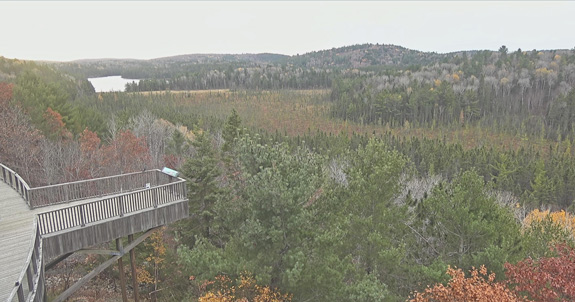
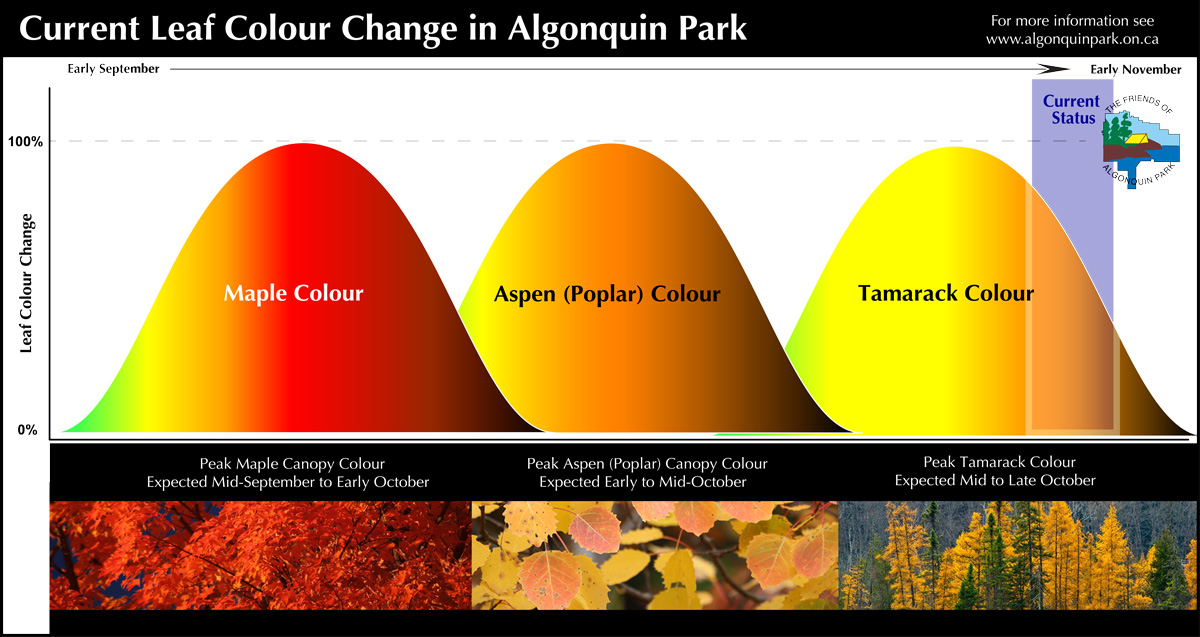
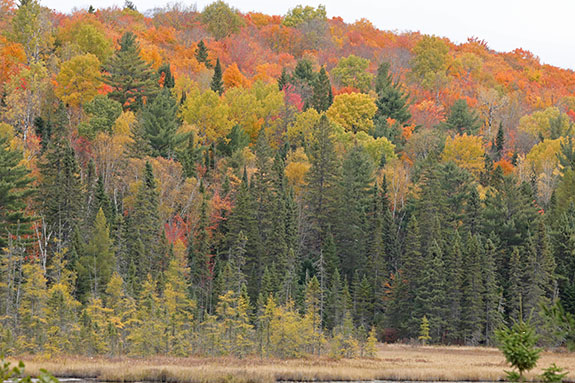
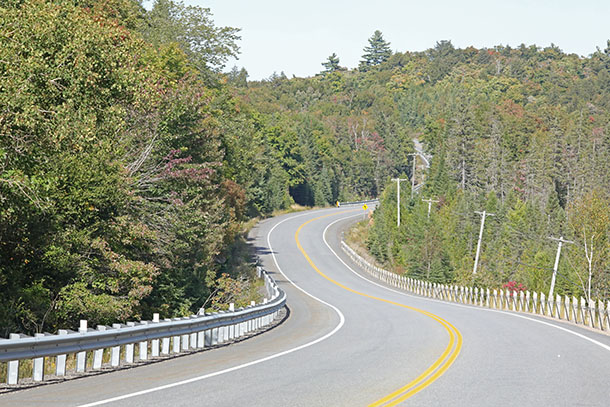

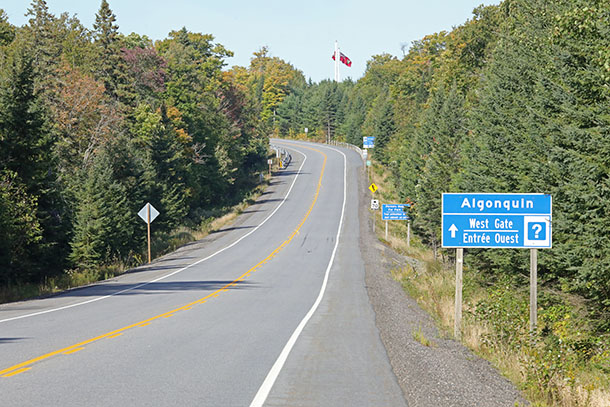
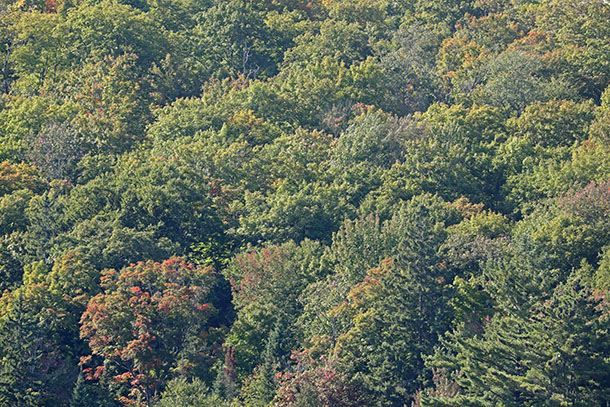
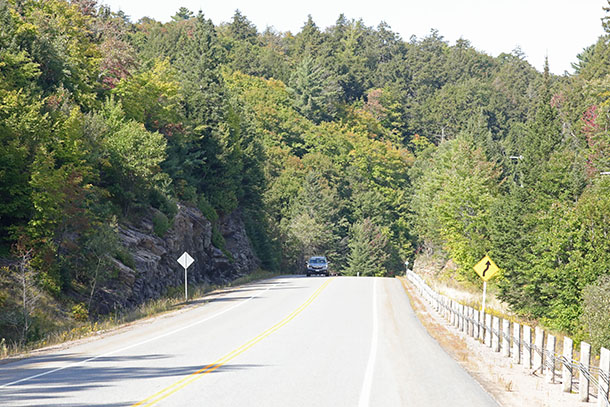
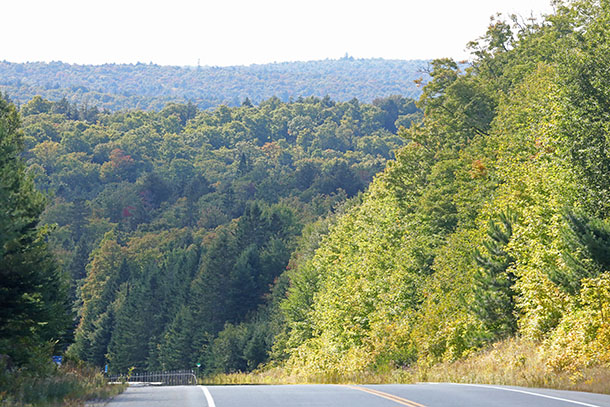
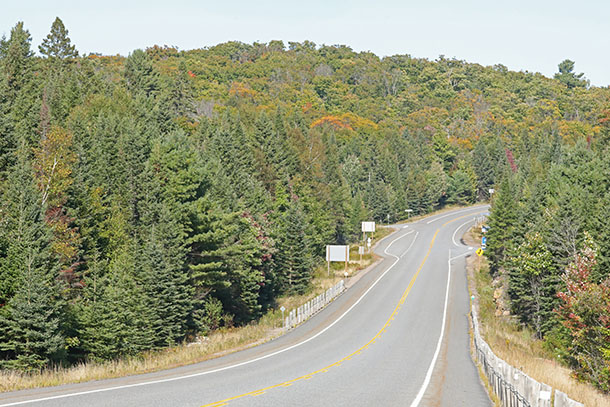
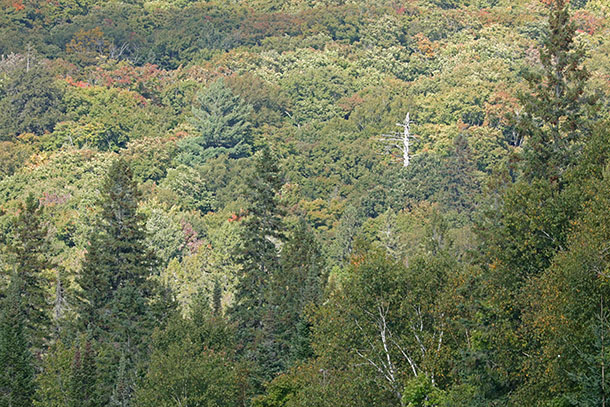
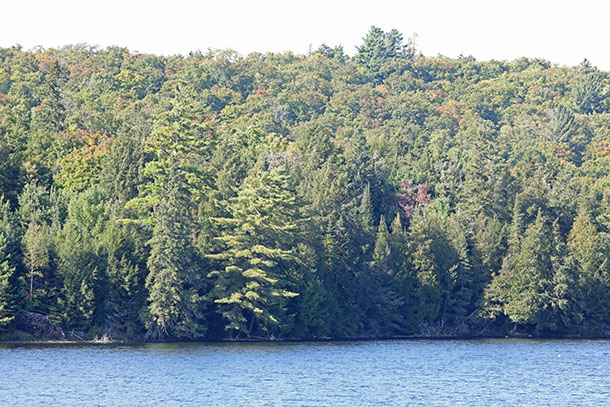
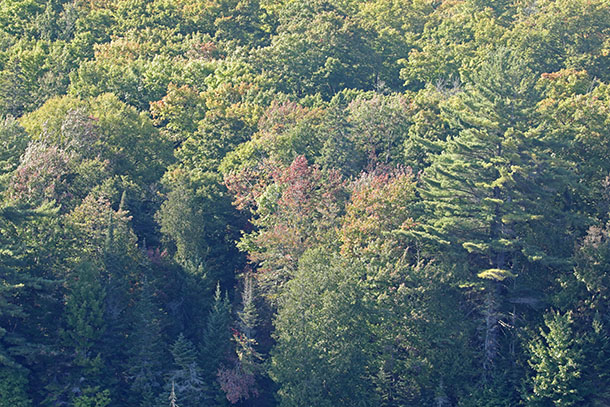
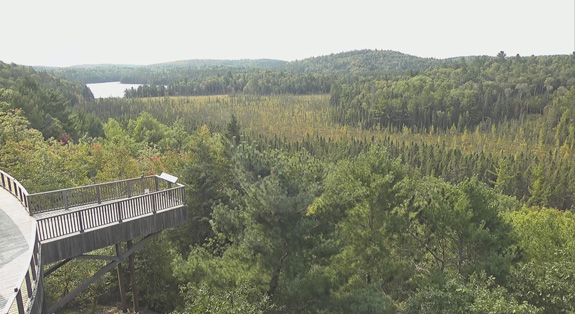
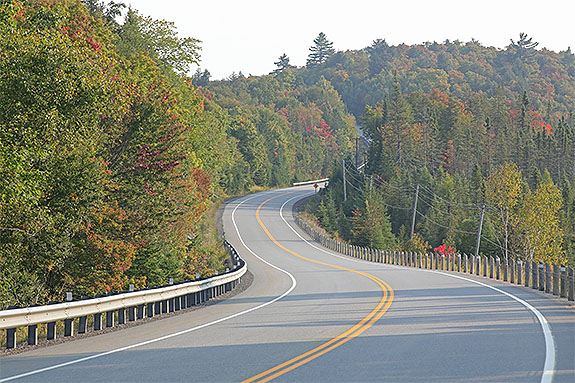
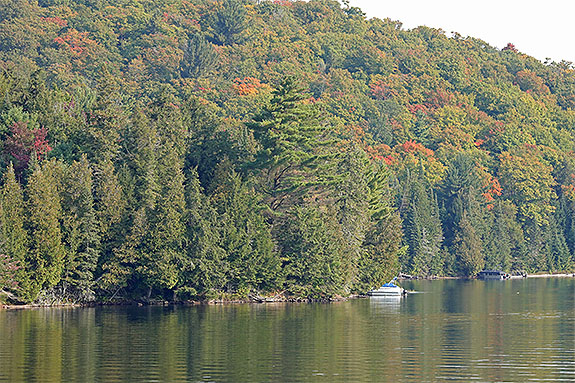
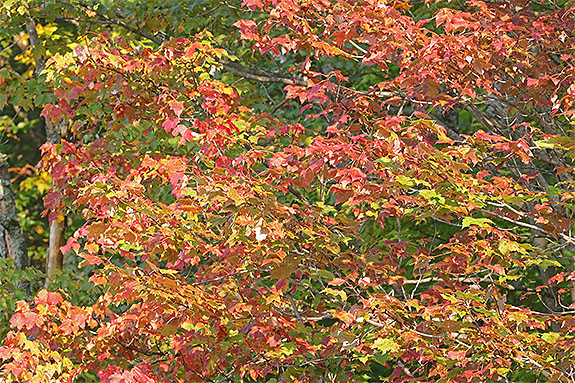
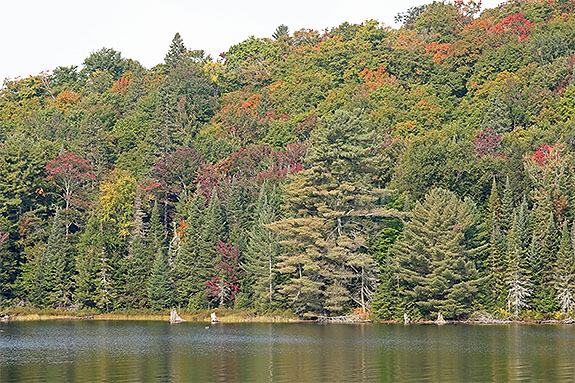
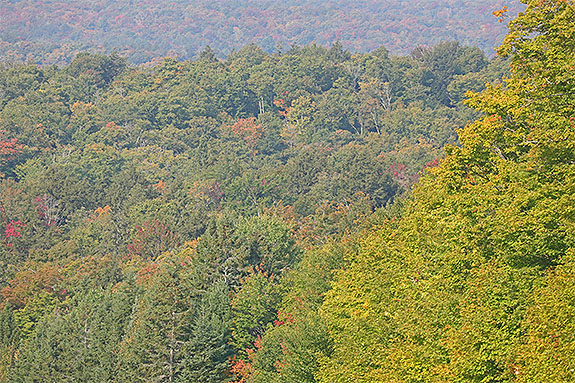
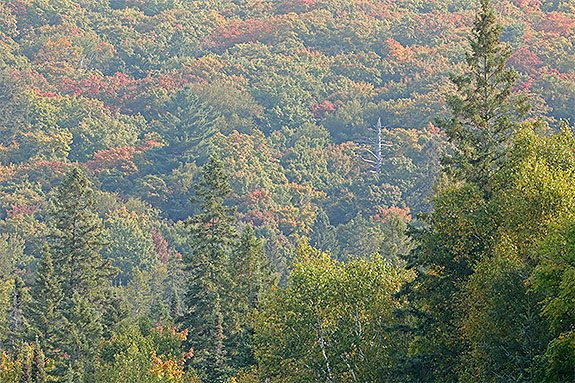
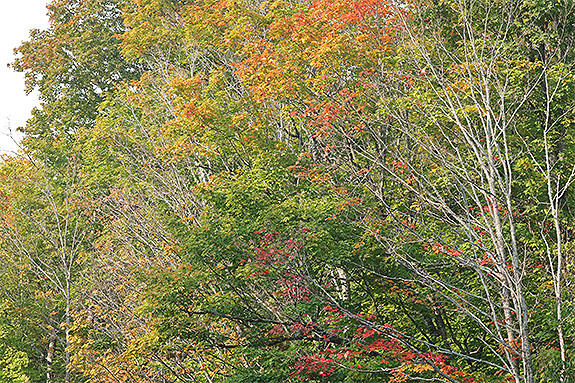
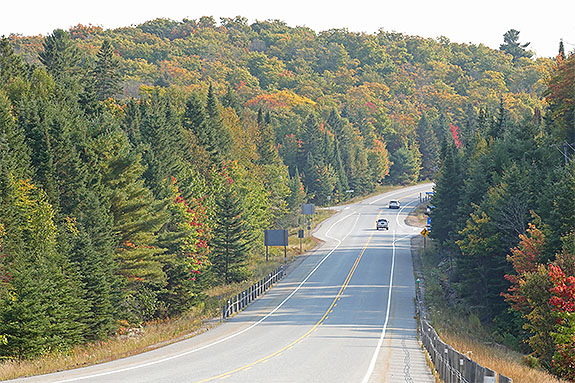
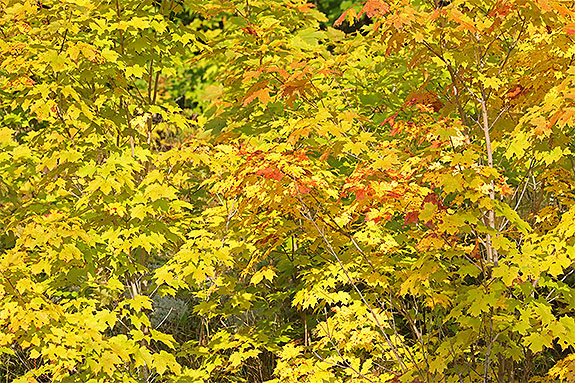

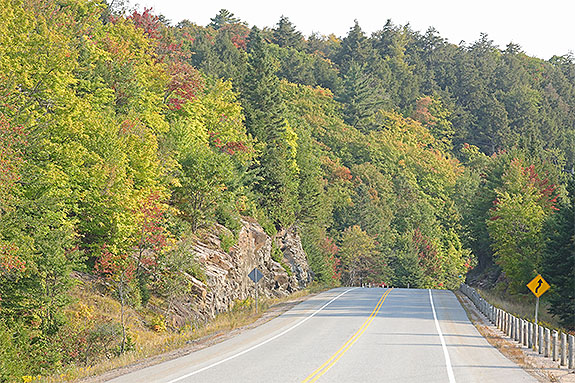
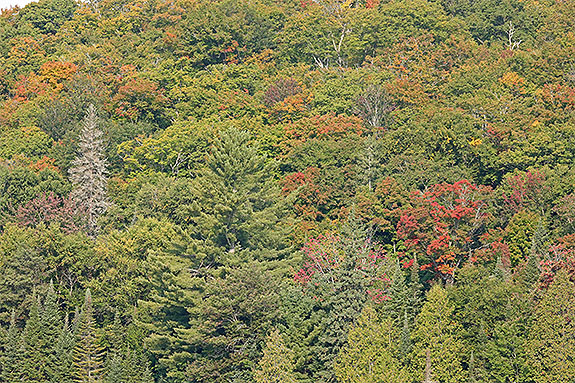
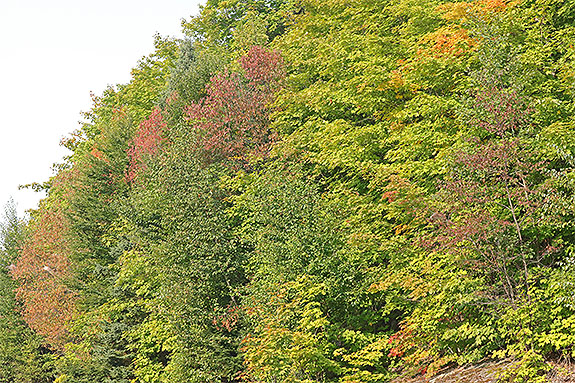
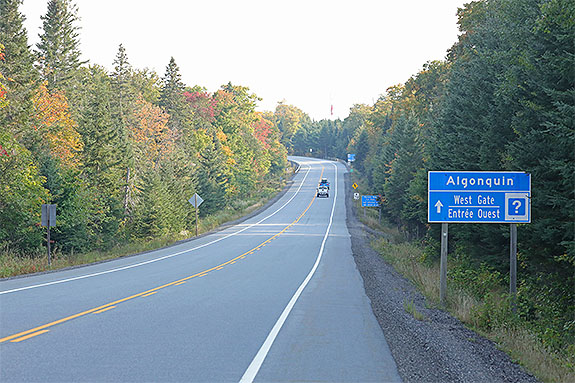
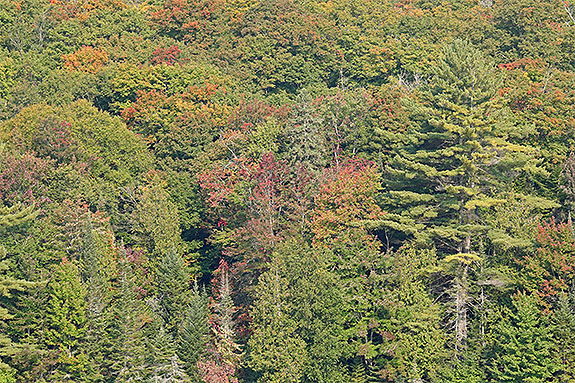
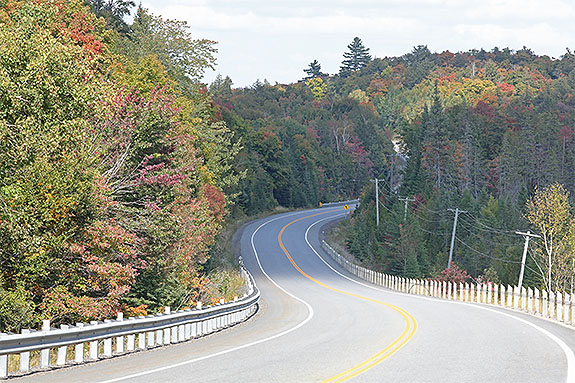
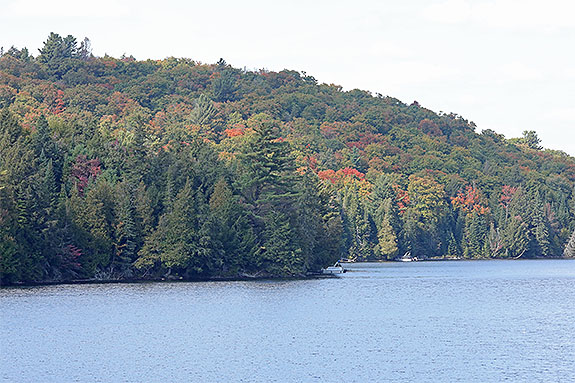
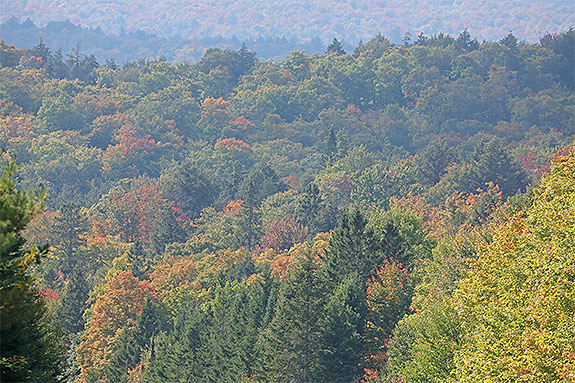
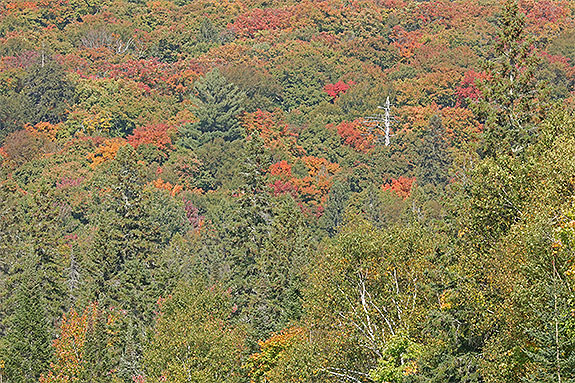
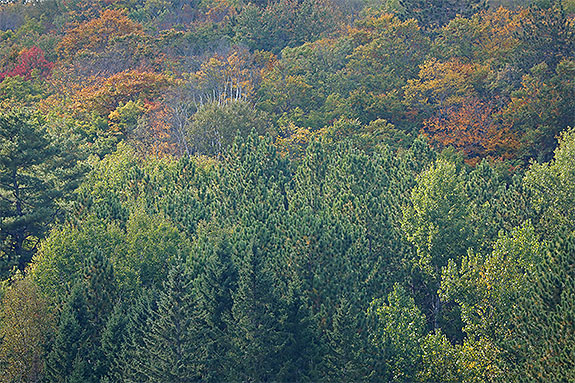
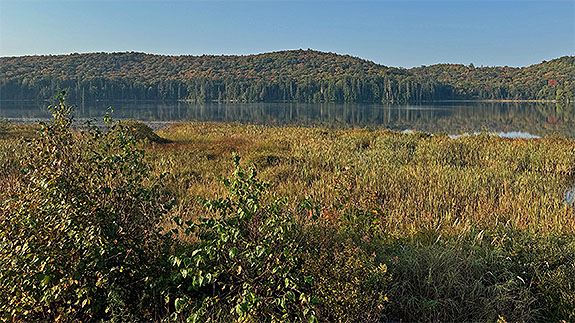

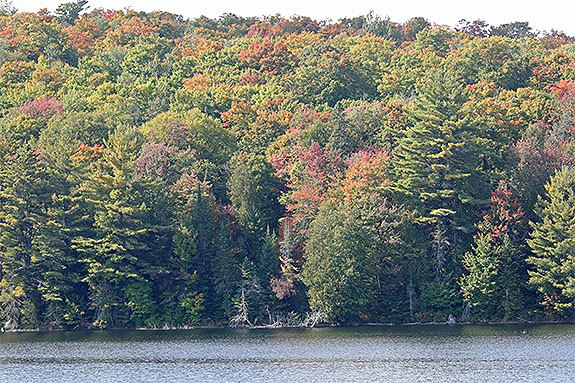
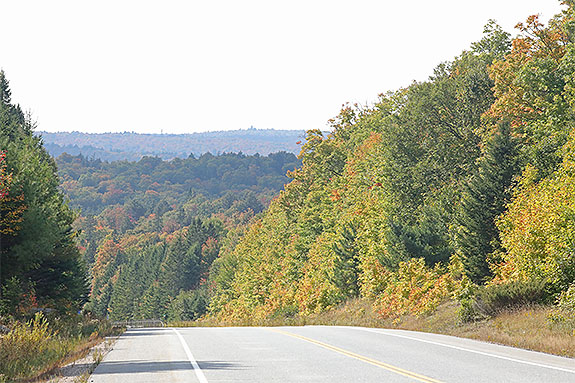
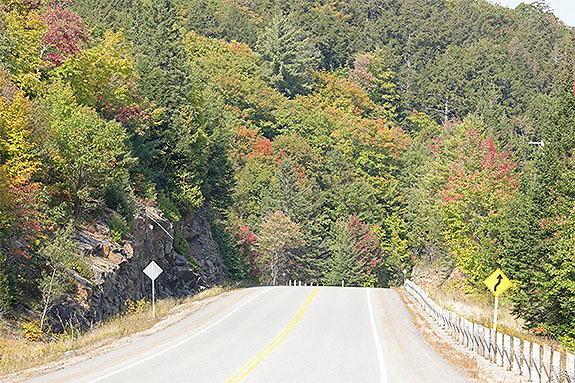
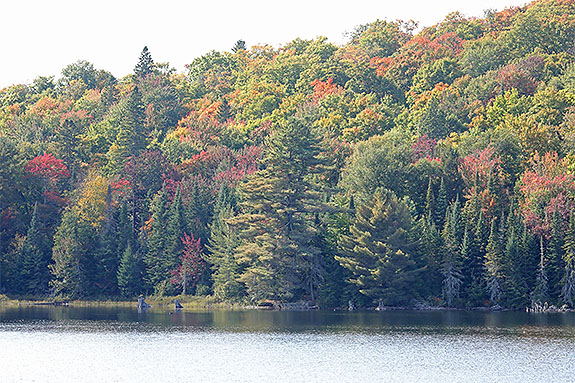
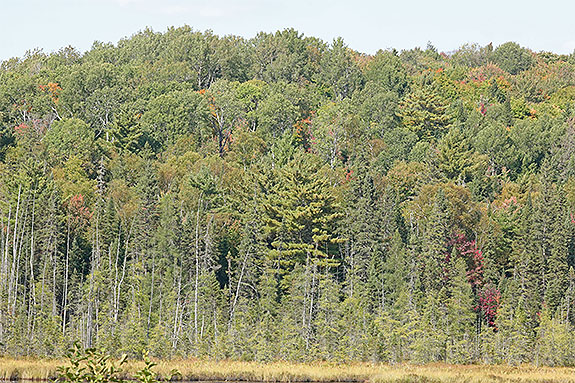
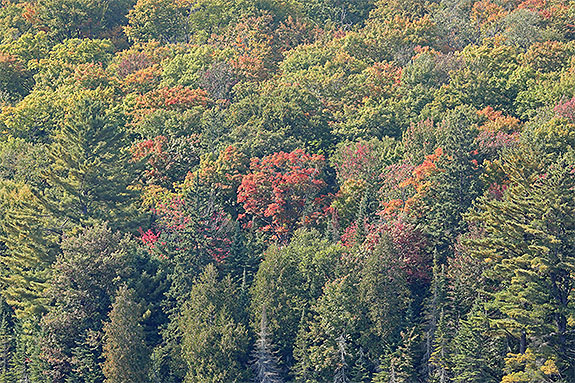
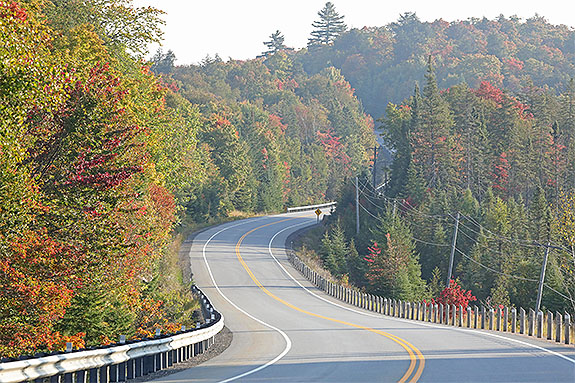
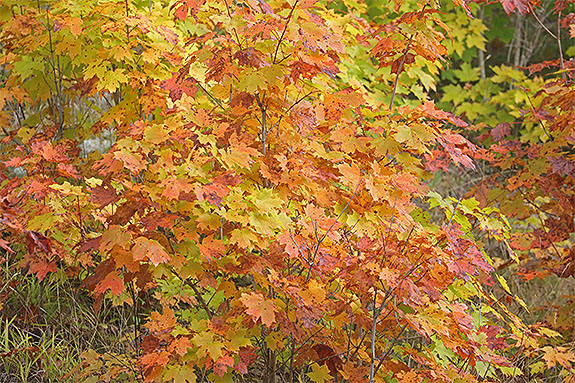
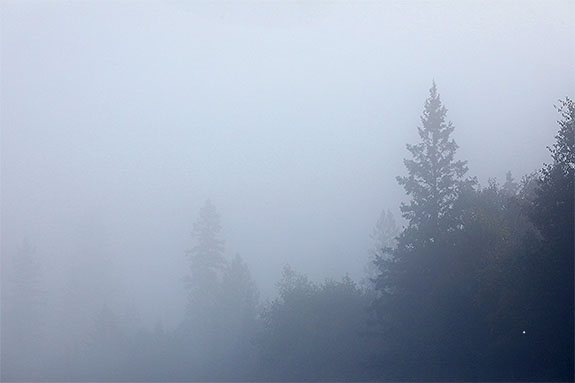
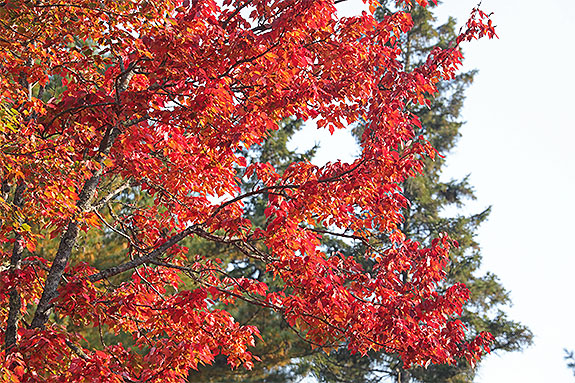
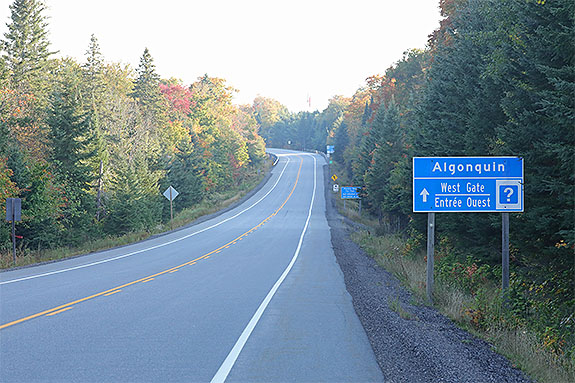
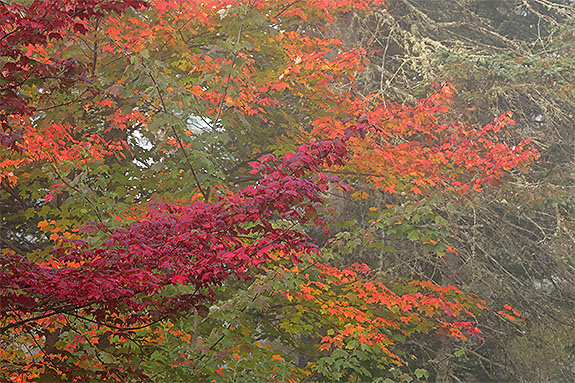
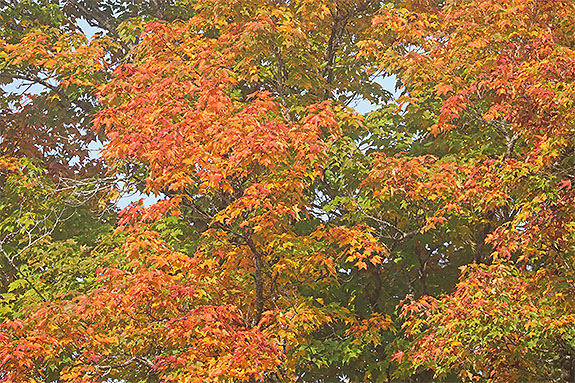
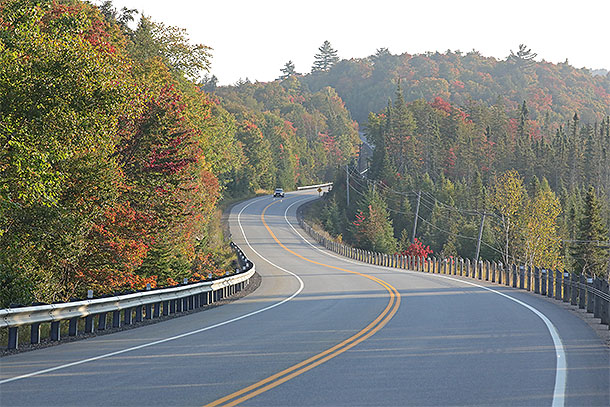
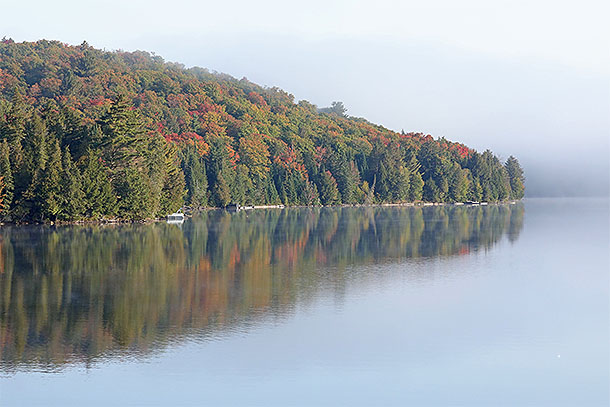
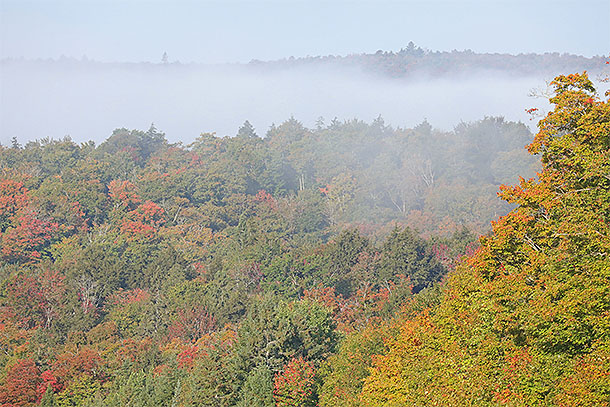
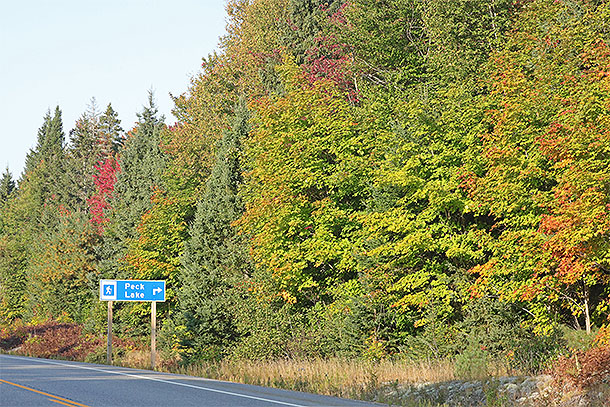
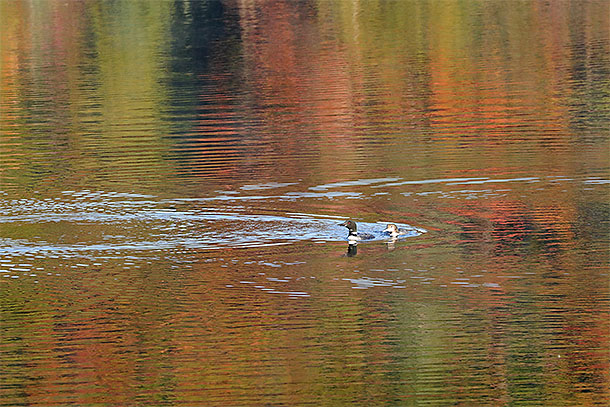
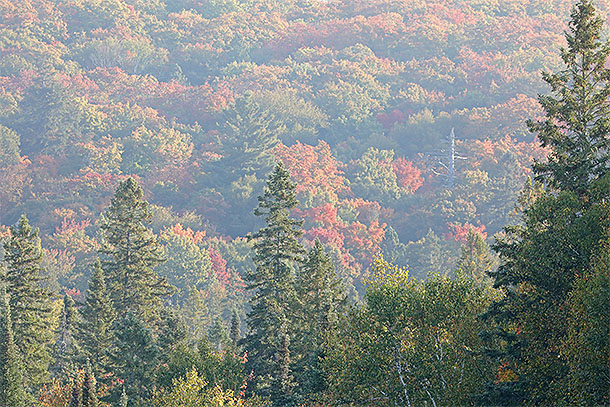
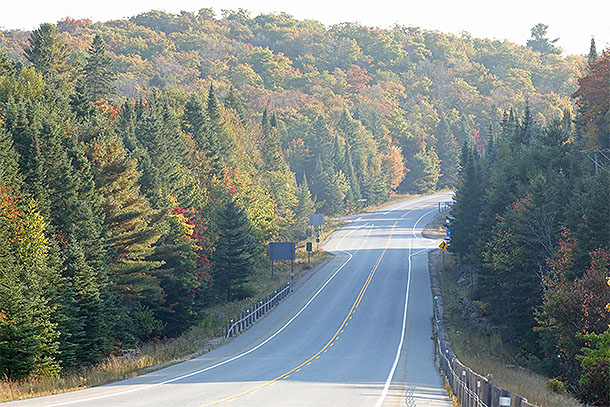
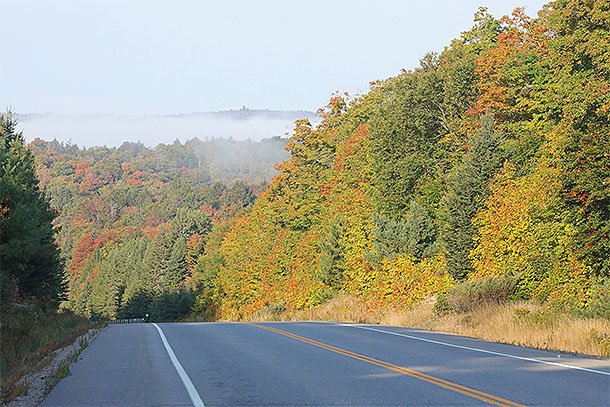
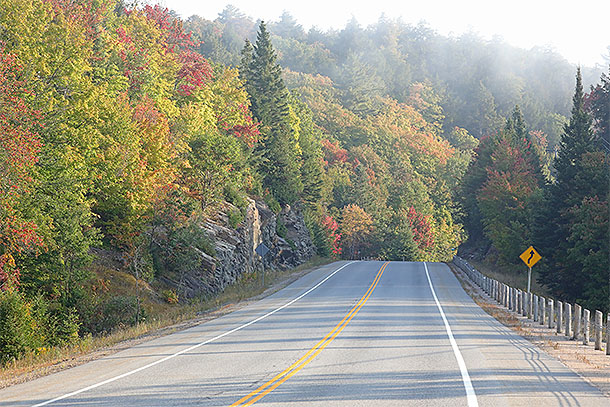
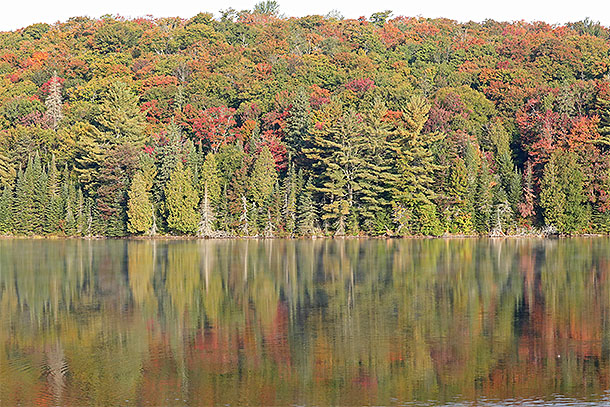
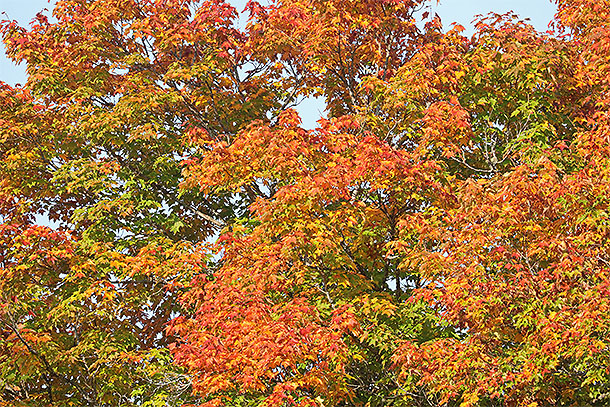
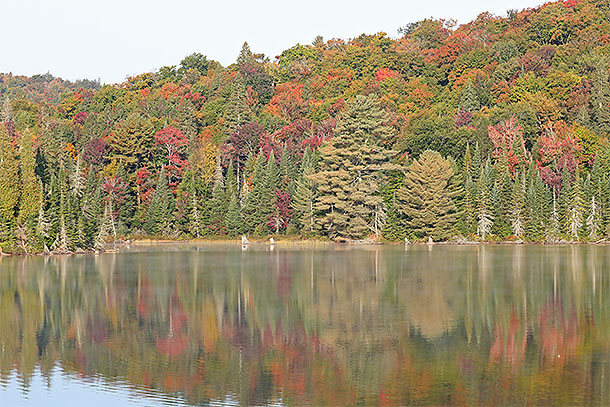
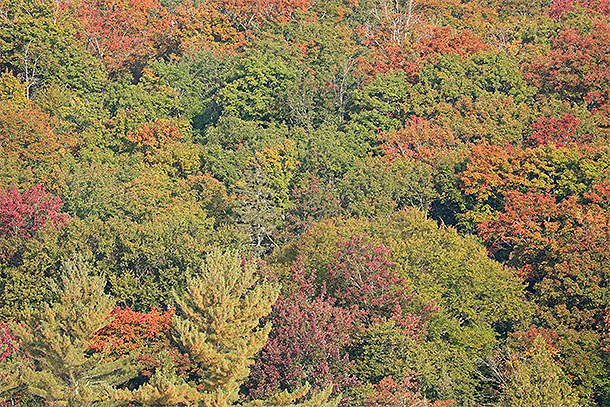
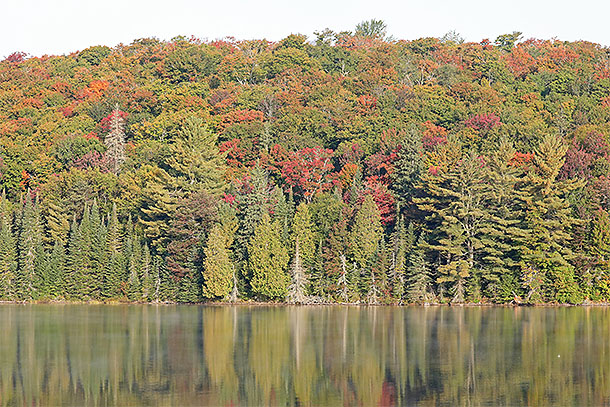
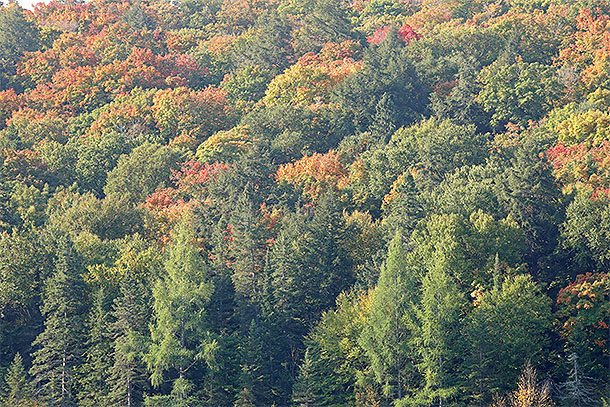
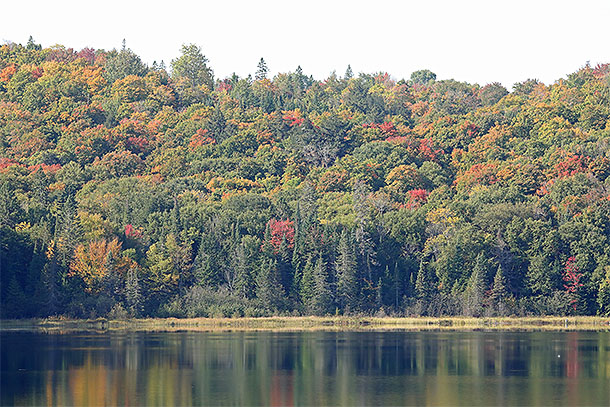
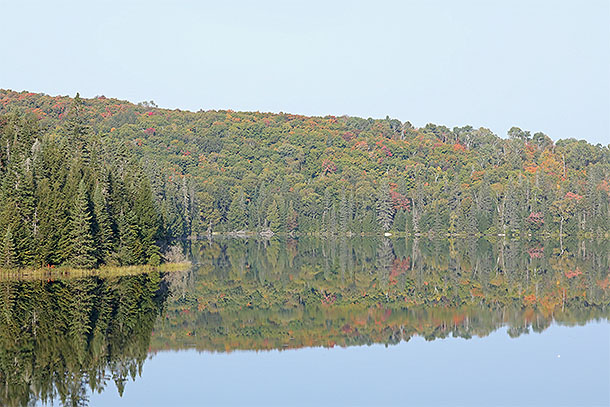
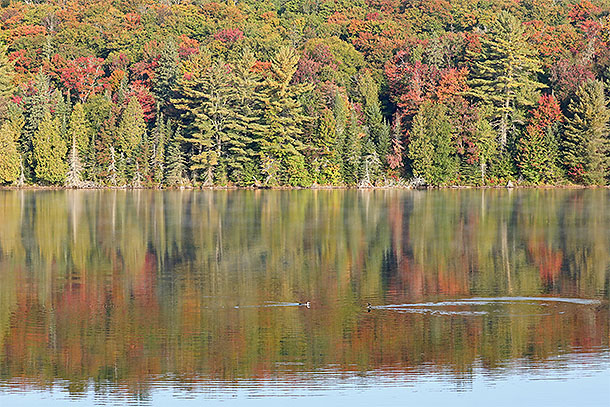
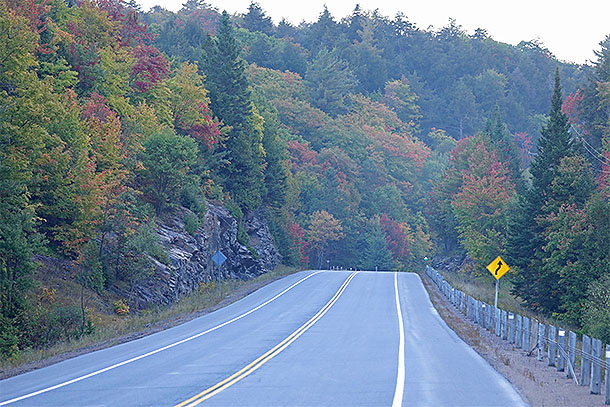
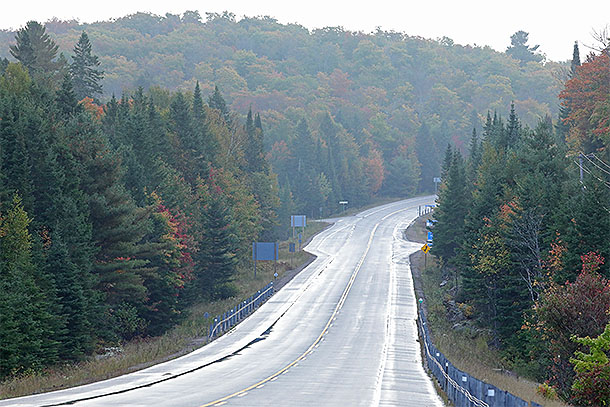
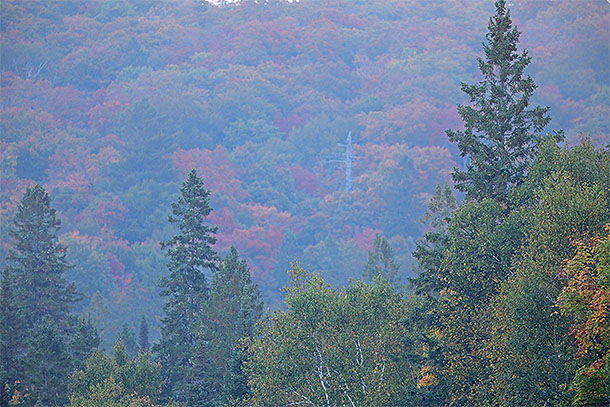
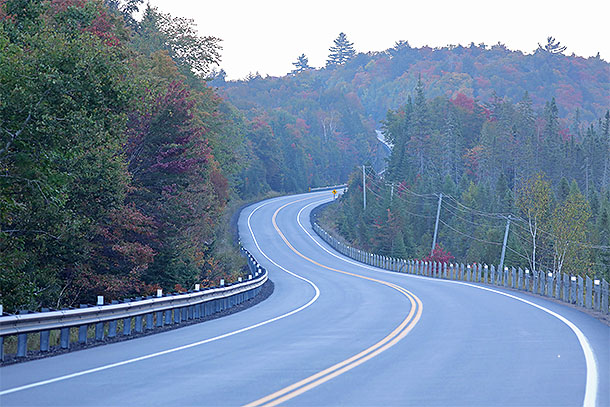
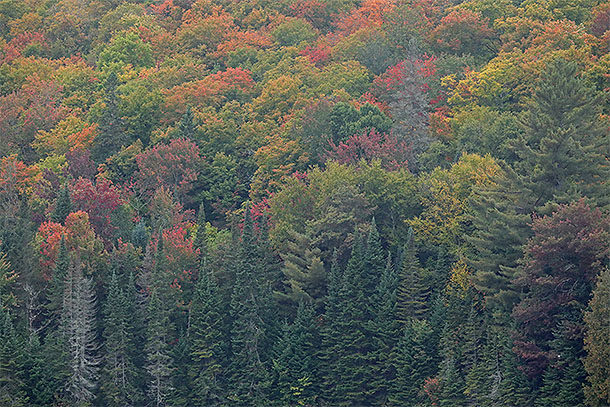
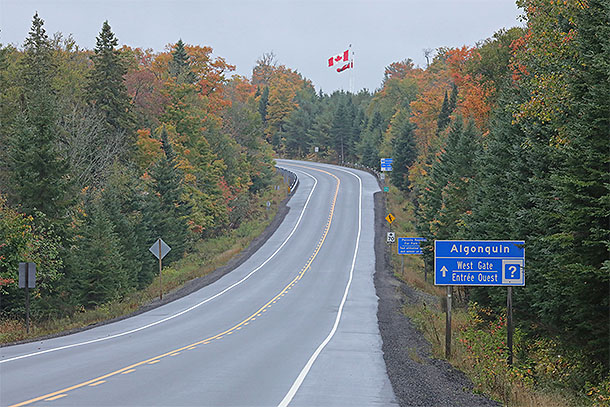
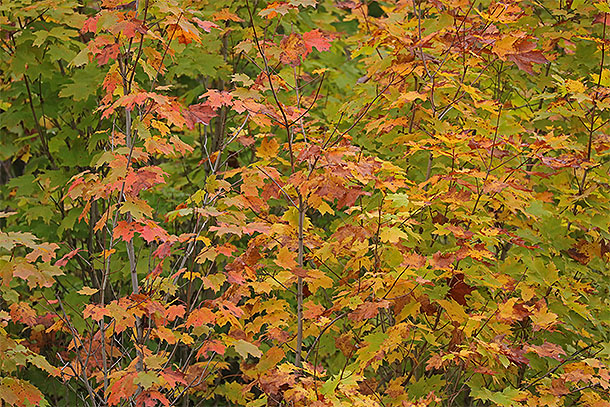
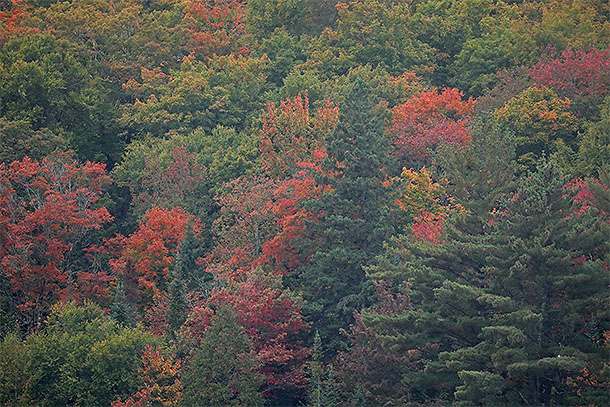
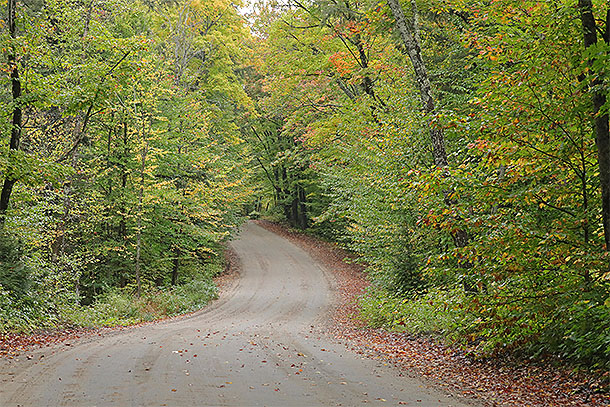
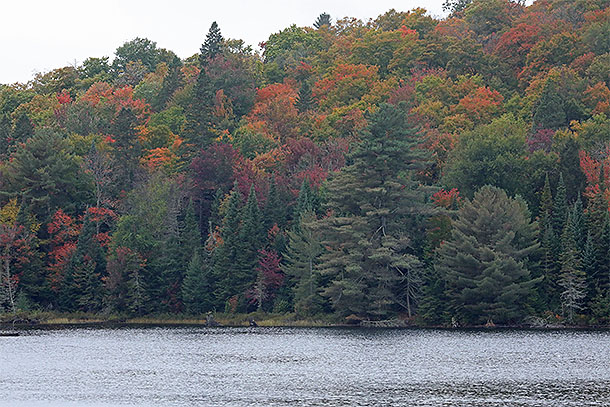
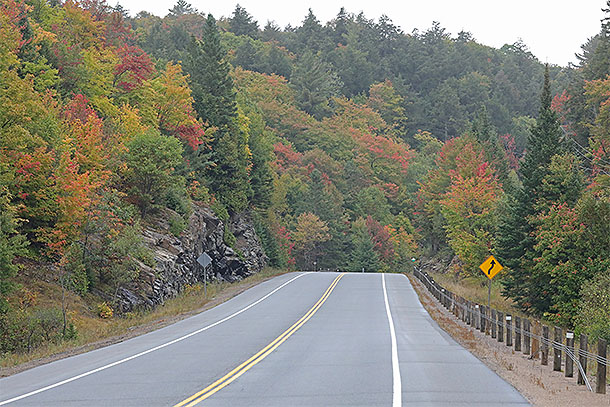
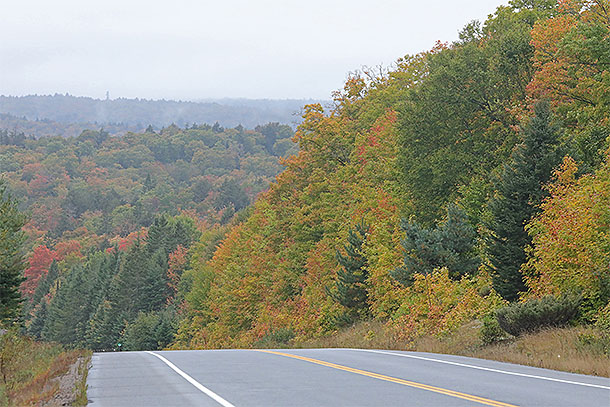
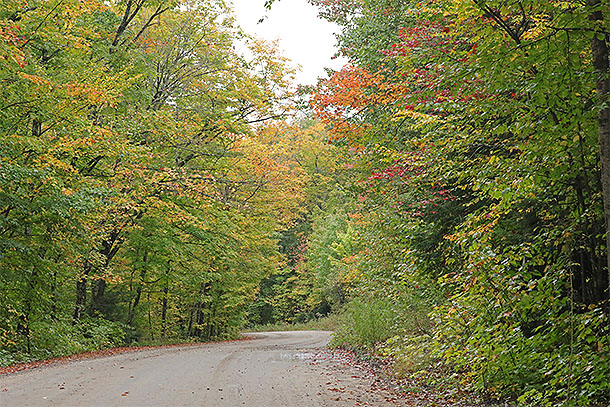
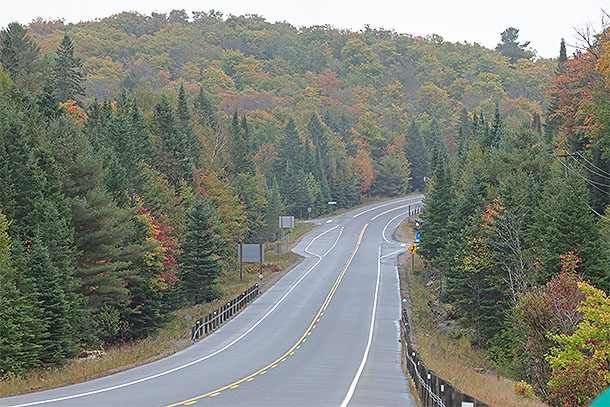
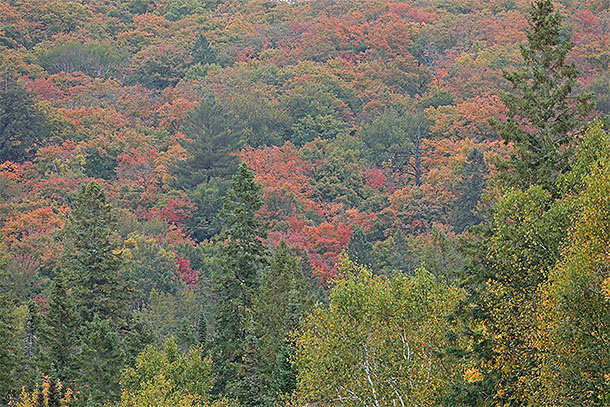
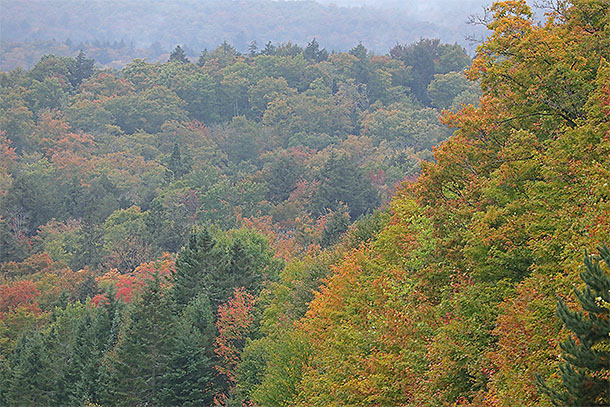
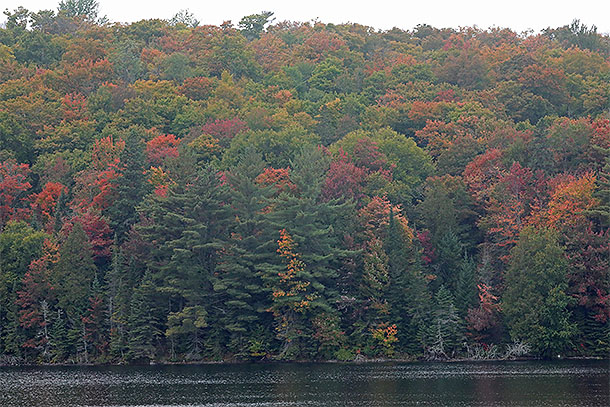
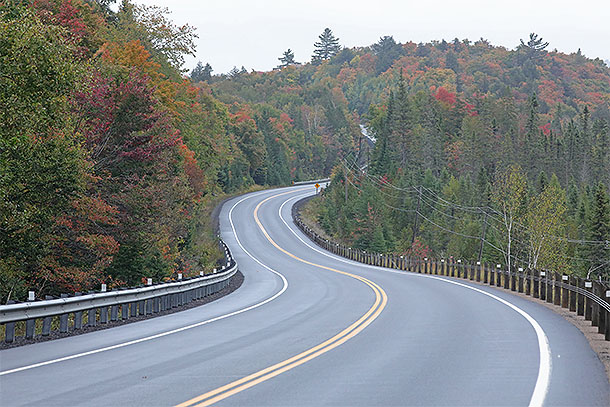
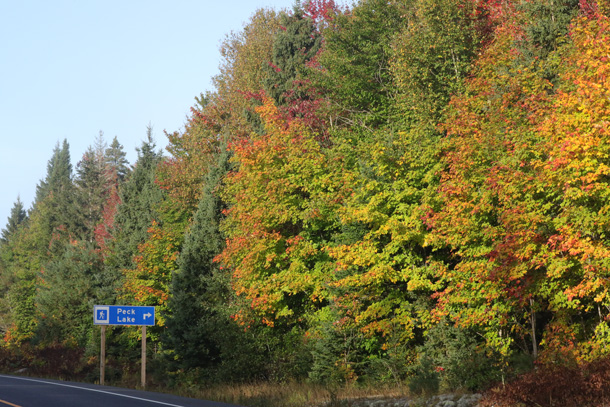
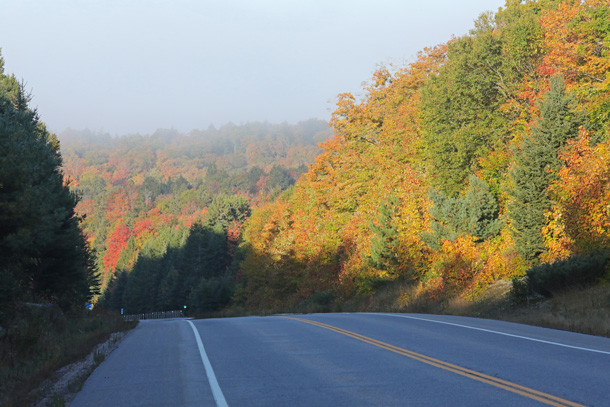
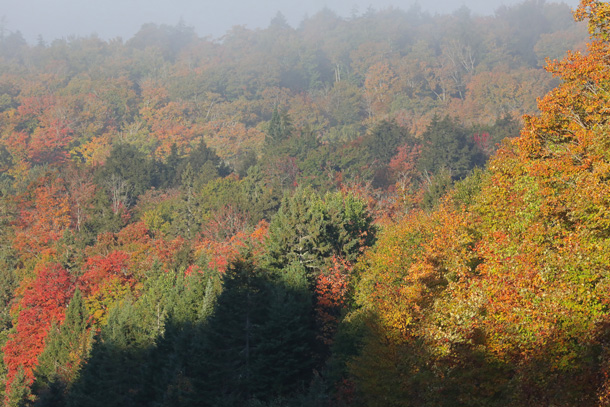
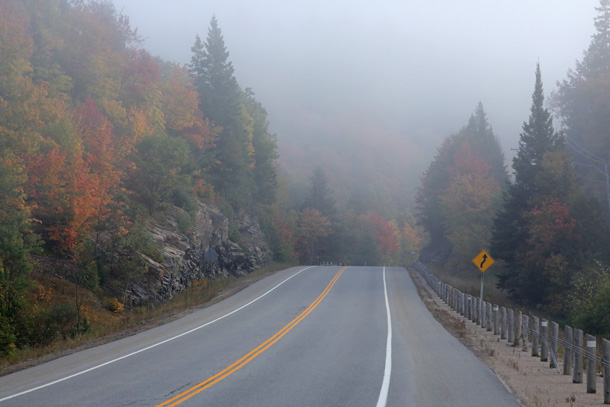
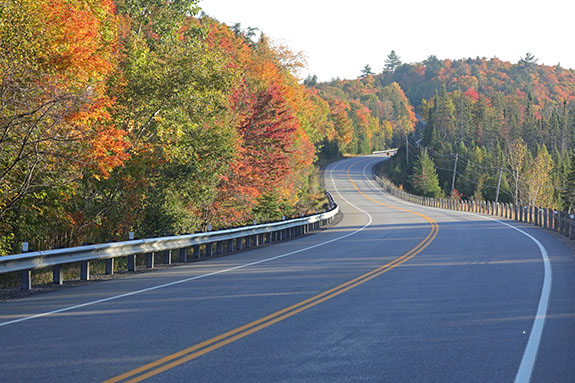
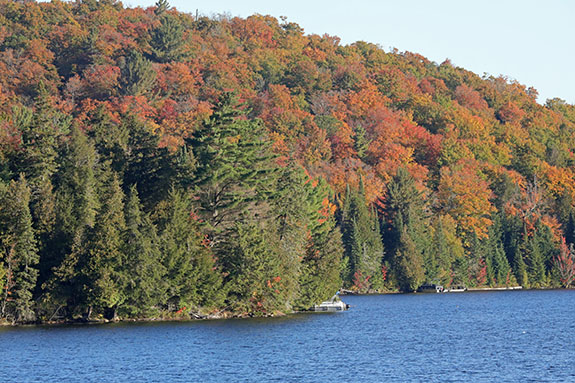
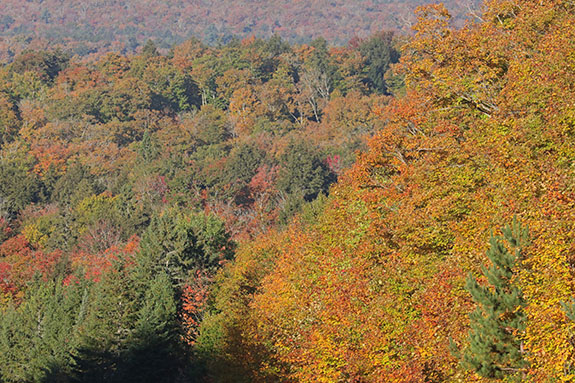
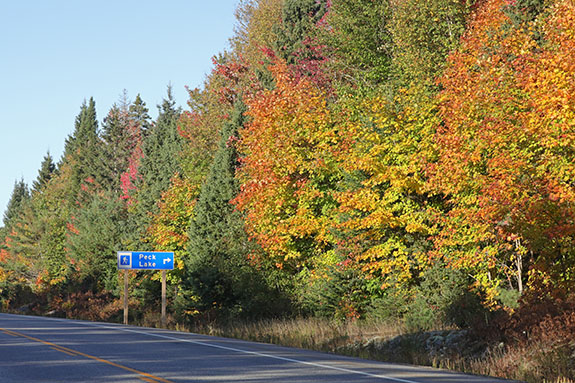

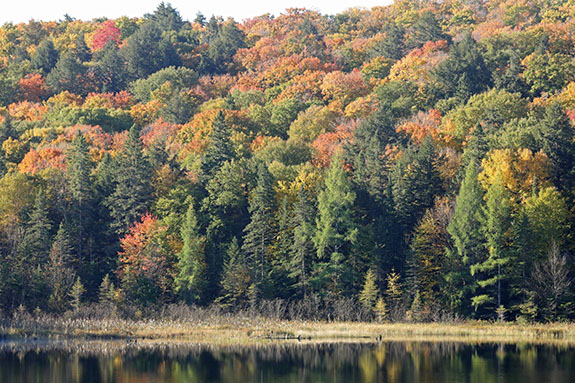
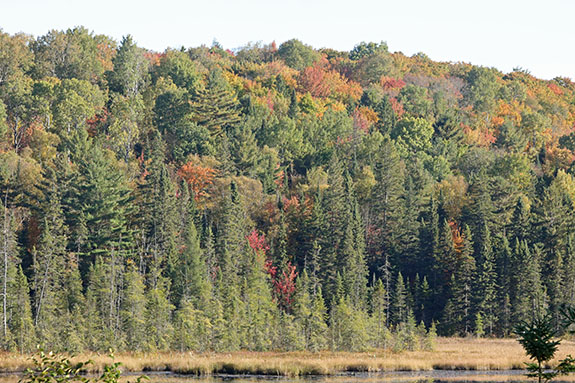
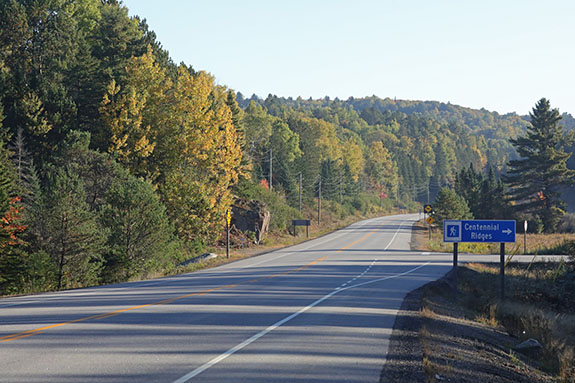
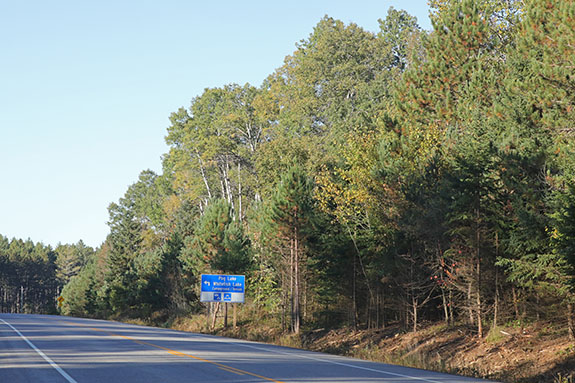
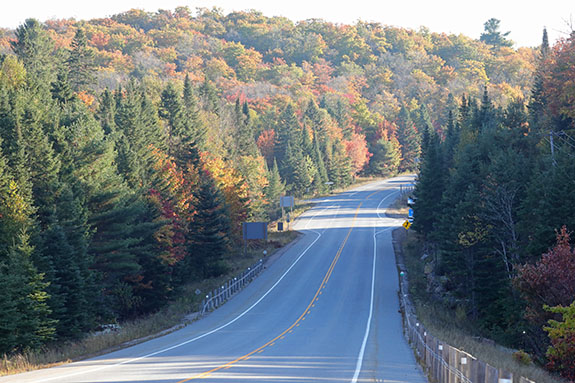
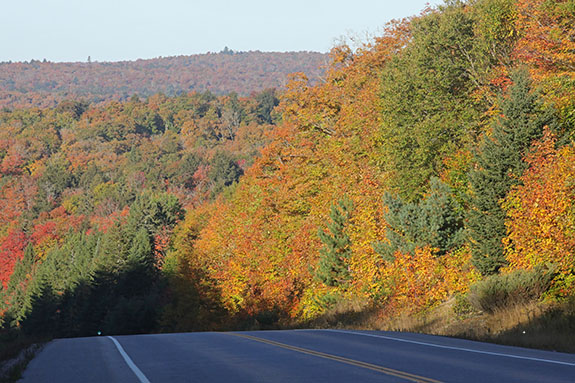
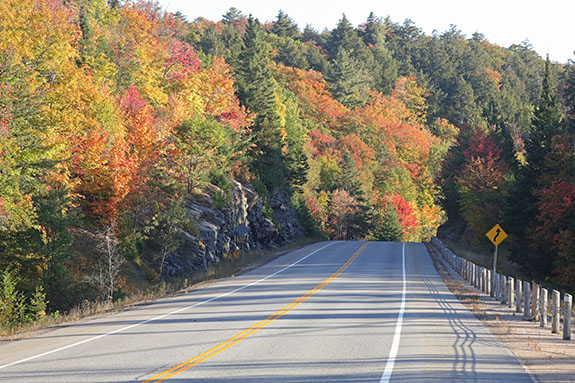
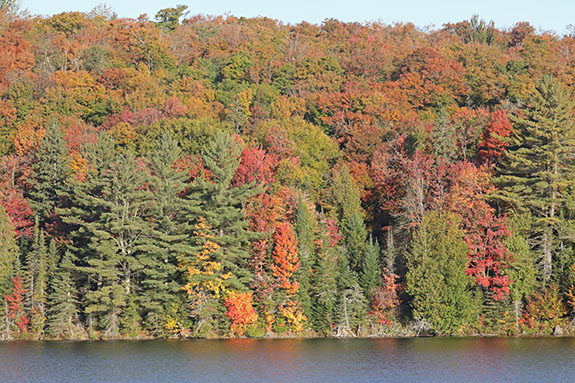
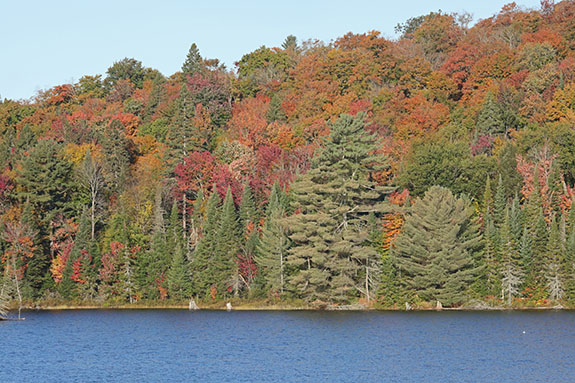
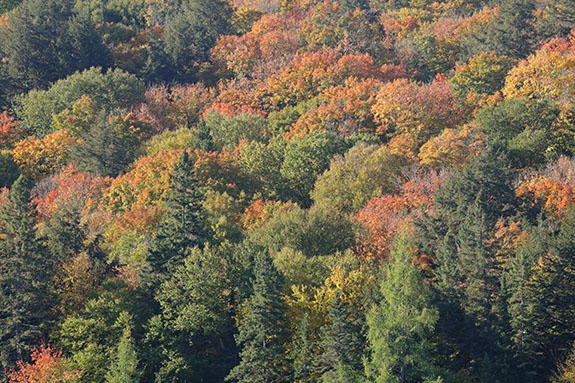
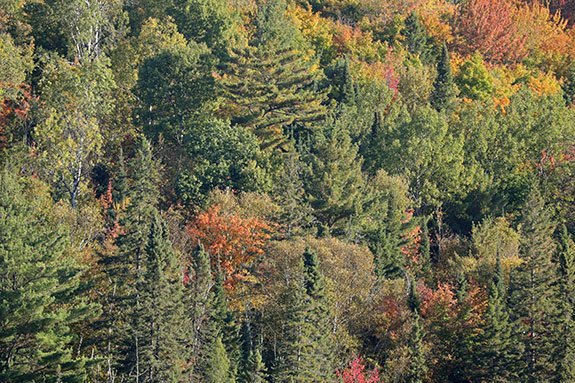
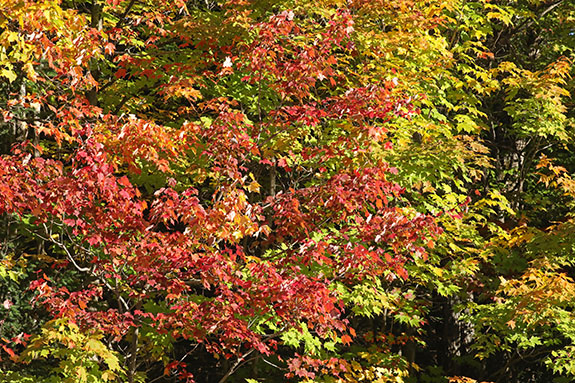
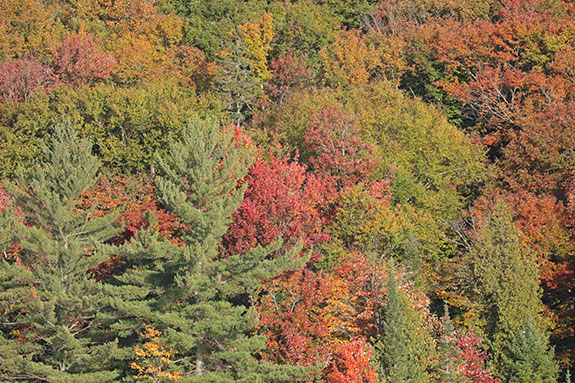
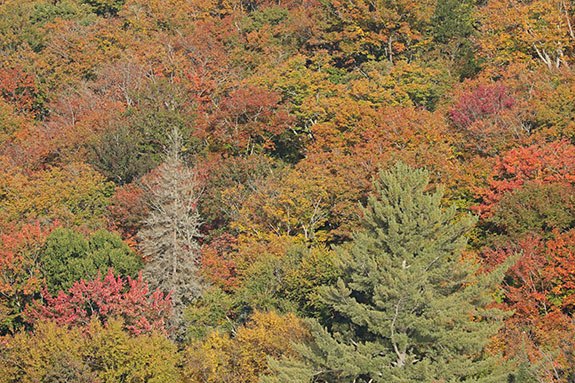
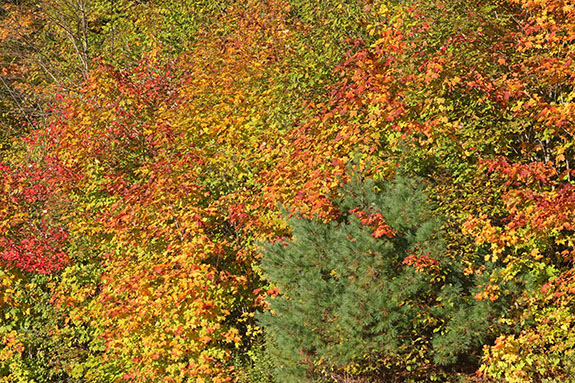
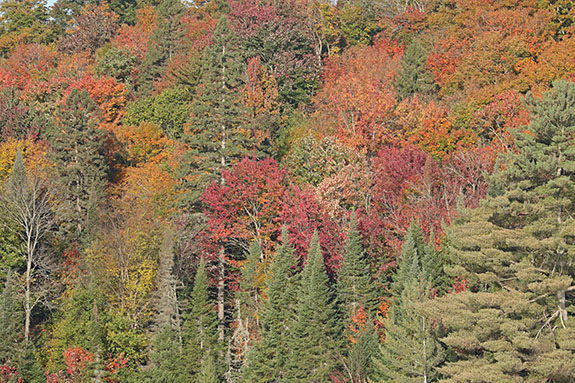
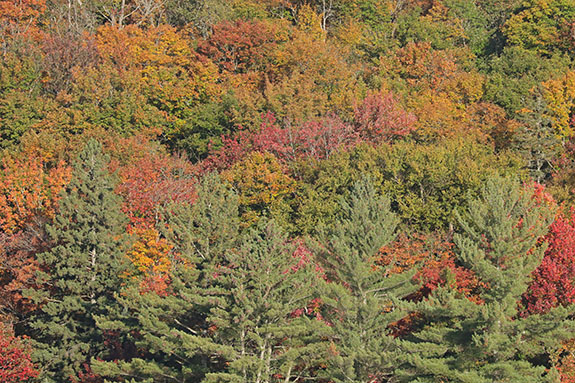
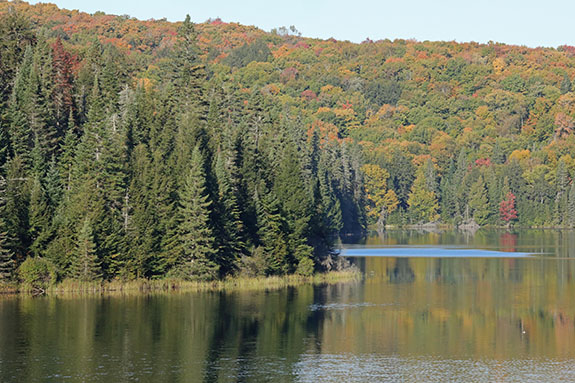
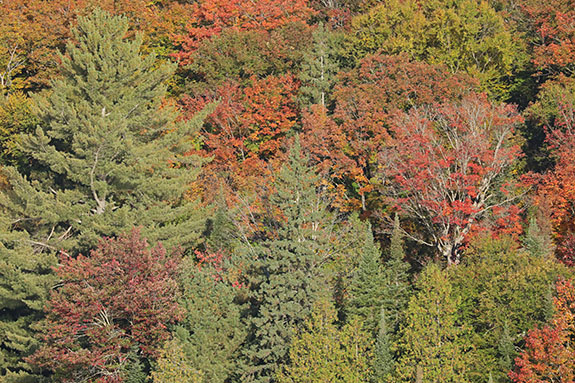
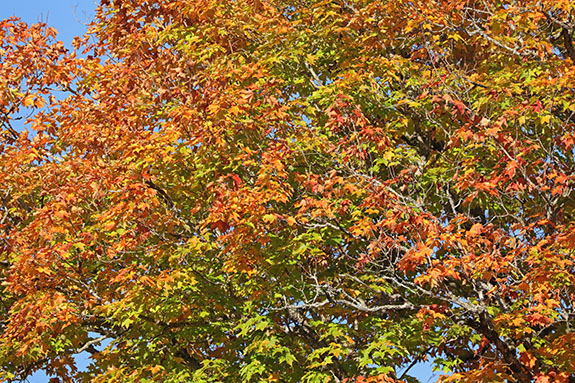
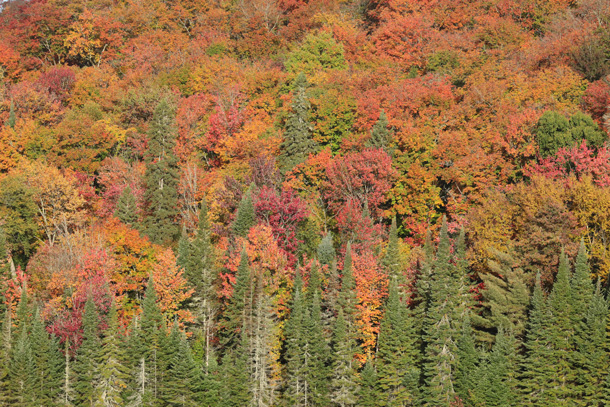
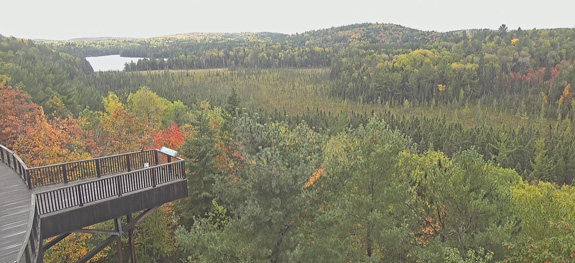
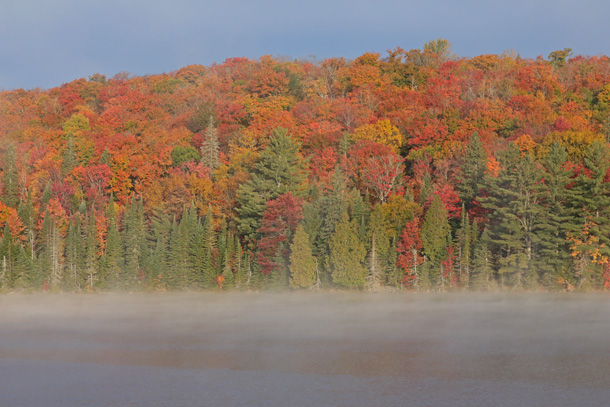
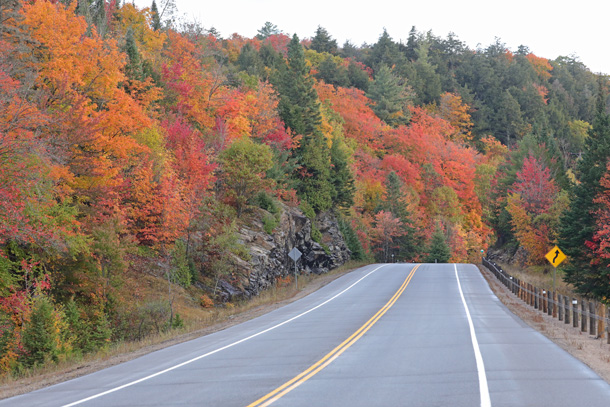
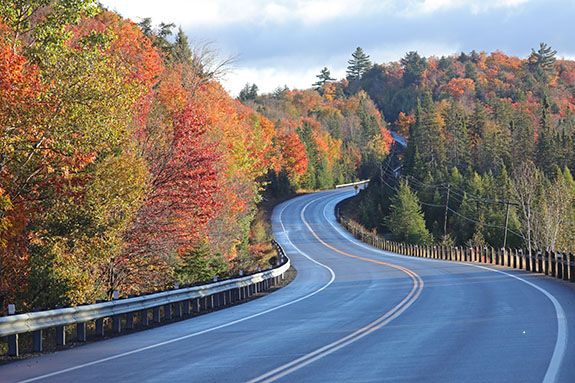
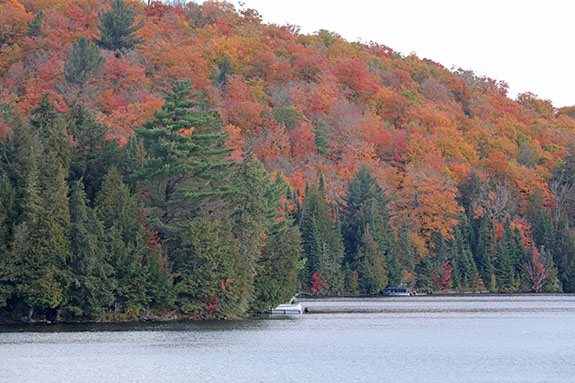
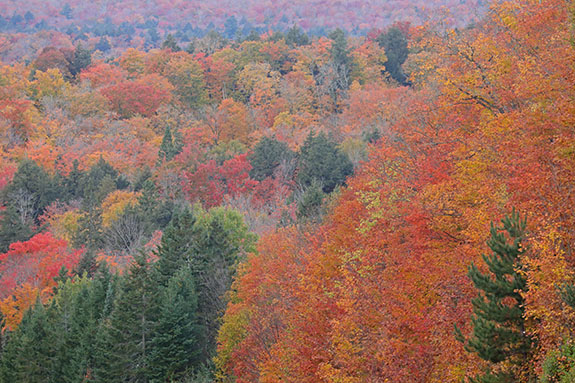
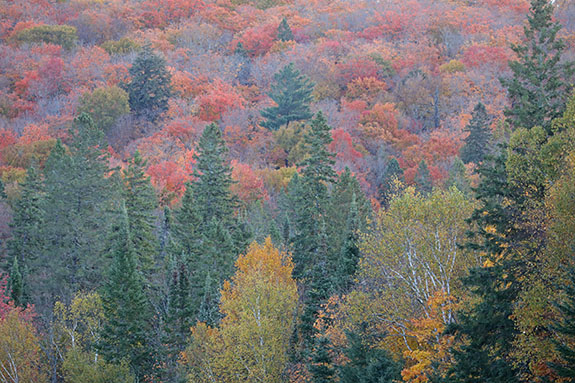
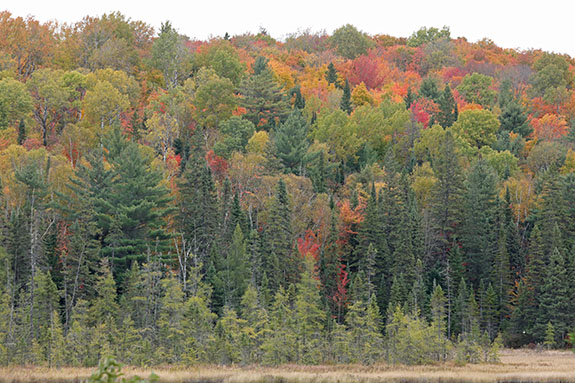
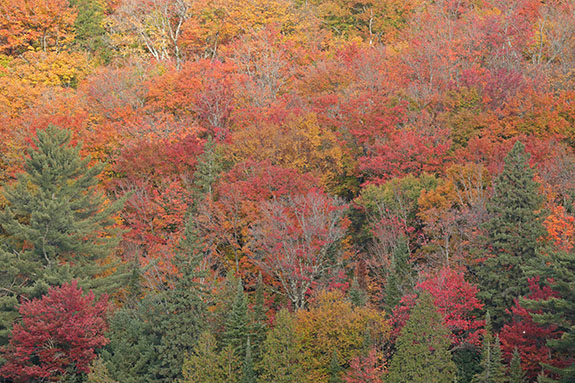
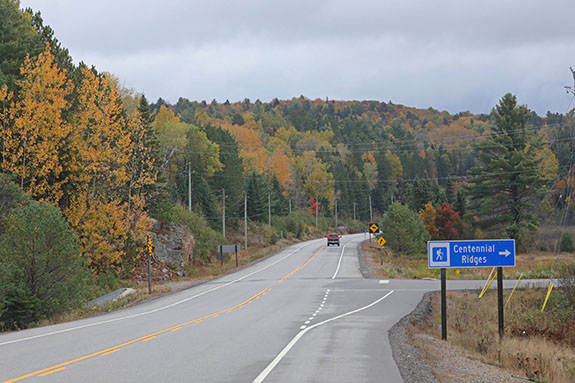
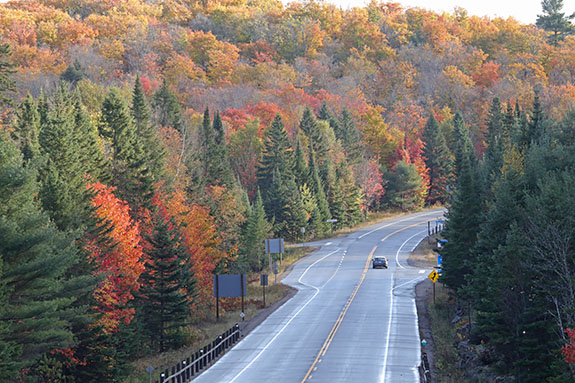
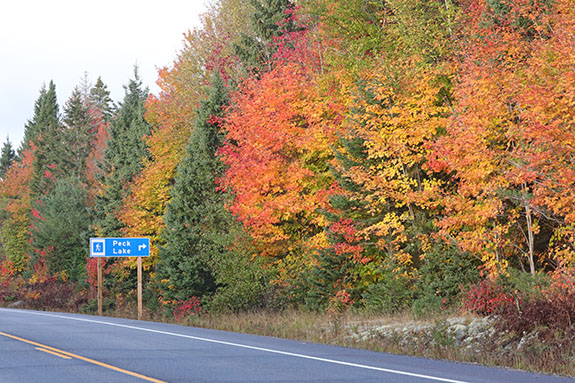
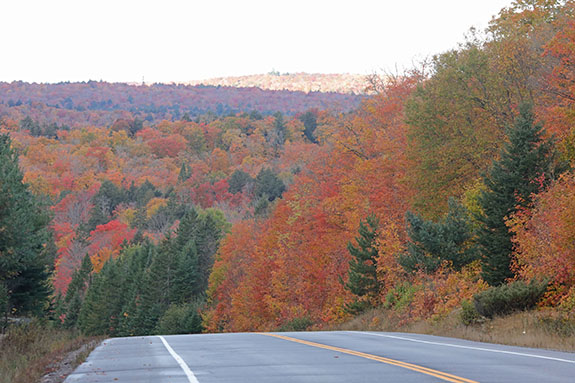
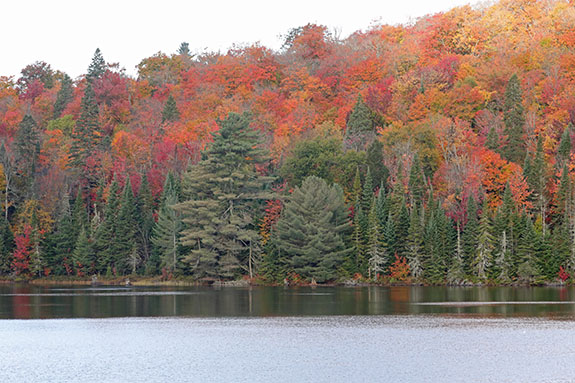
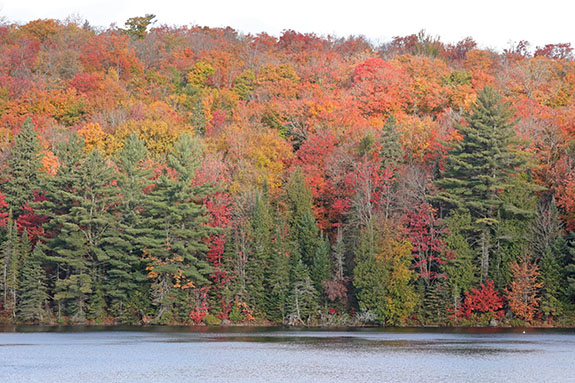
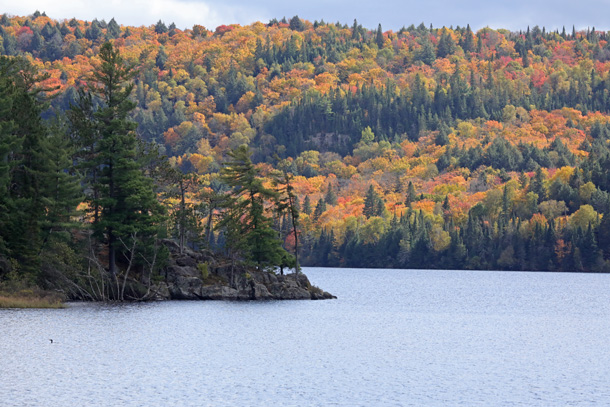
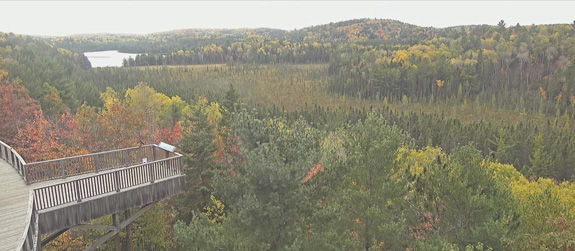
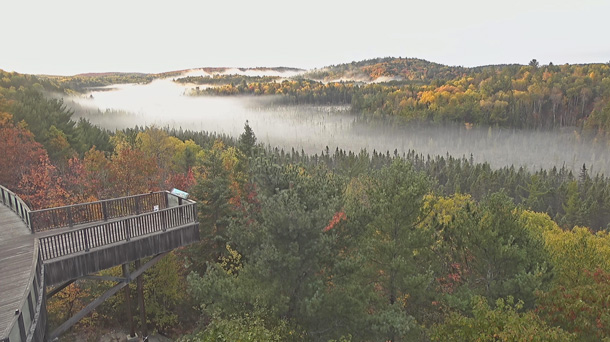
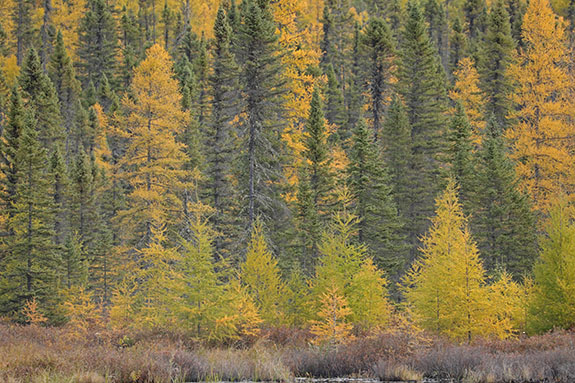
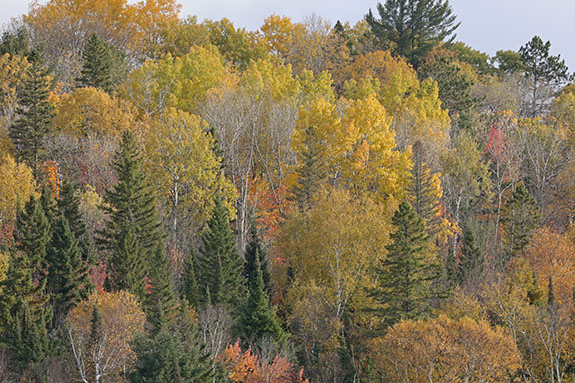
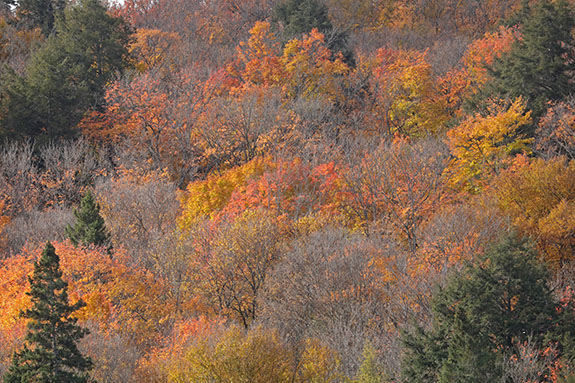
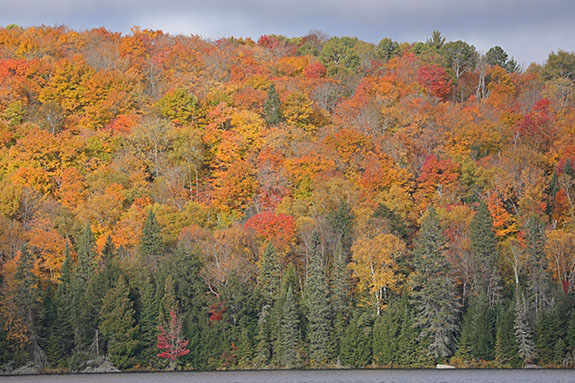
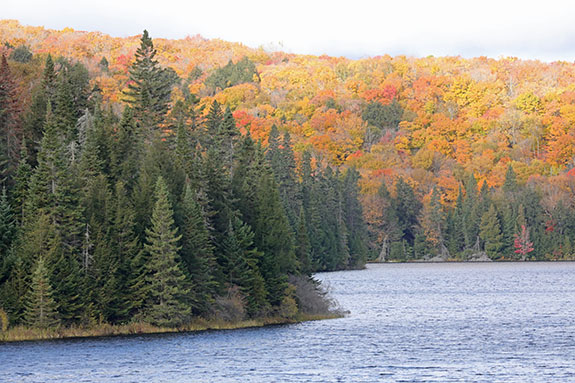
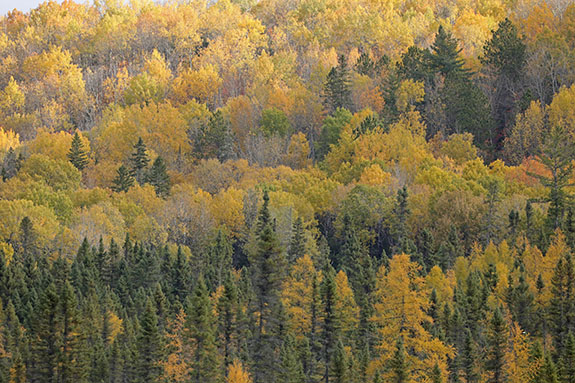
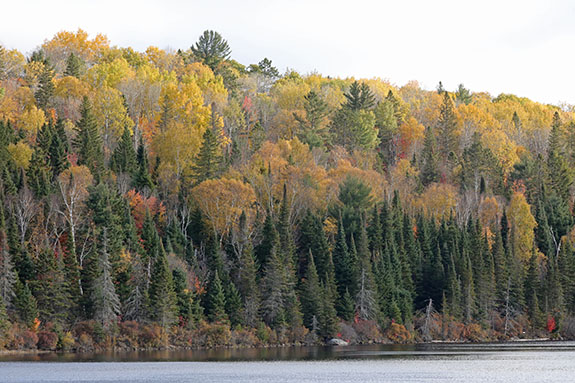
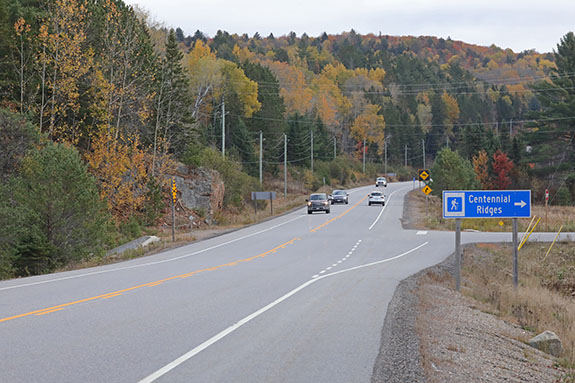
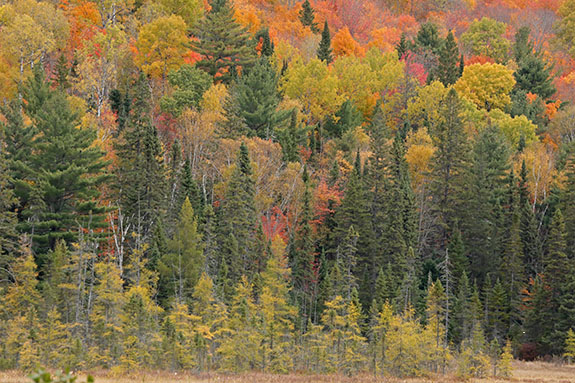
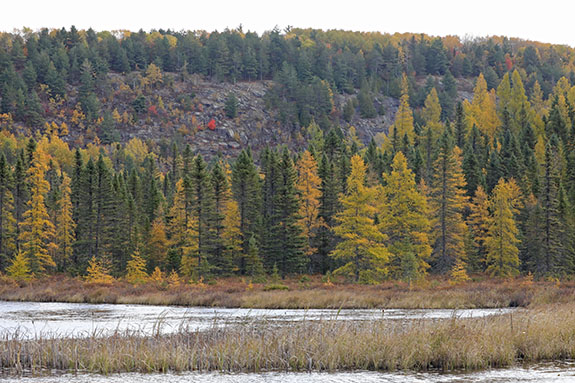
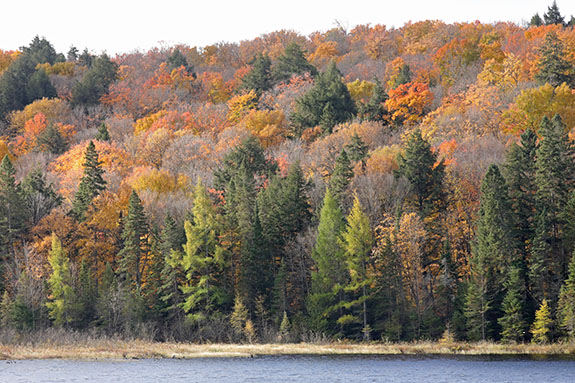
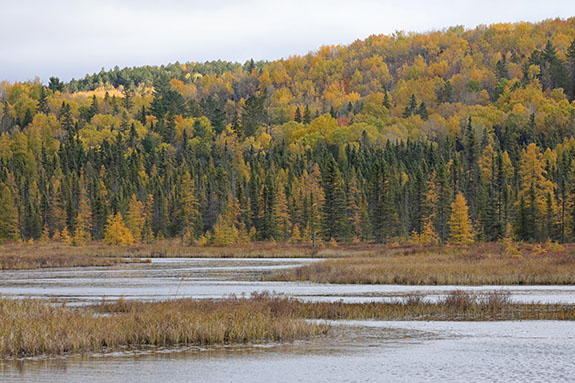
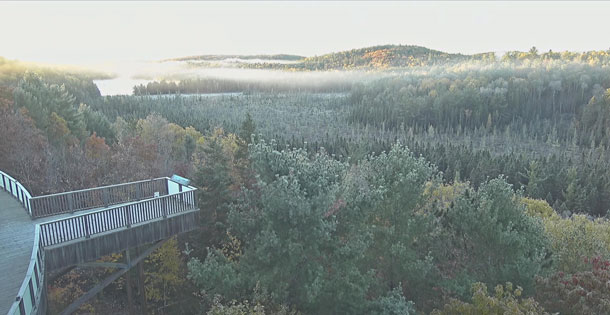
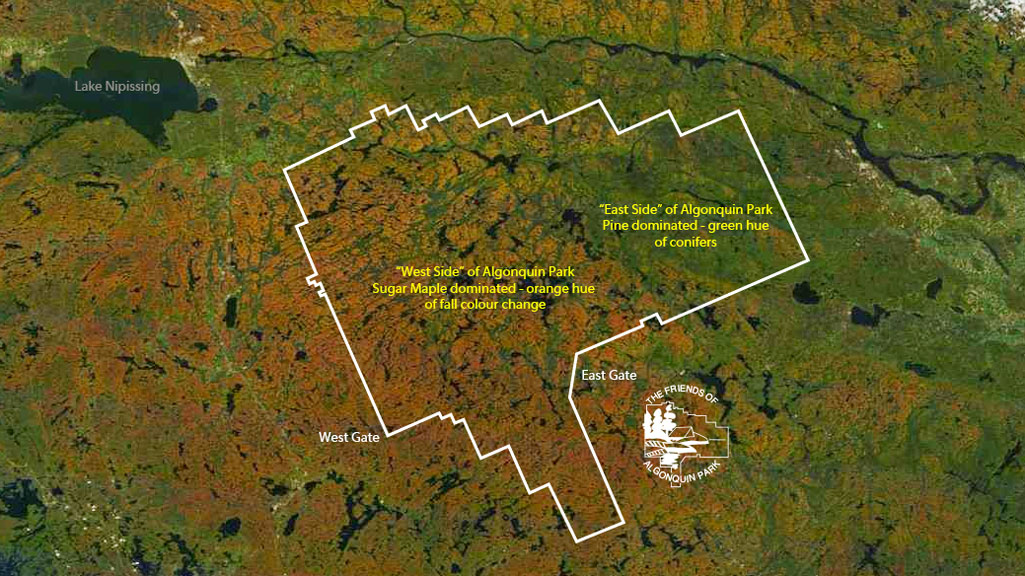
 Ontario Parks requires the online (or telephone) purchase of day use permits up to 5 days in advance, with capacity limits for each day.
Ontario Parks requires the online (or telephone) purchase of day use permits up to 5 days in advance, with capacity limits for each day. 